NTT DATA CORPORATION / Remote Sensing Technology Center of Japan.

Contributions to and effects on biodiversity conservation
The Company's AW3D Map service makes it possible to identify topography changes caused by natural disasters, the situation of resource extraction at mines, and the situation of forest growth across extensive areas with high accuracy. Therefore, it can contribute to the monitoring and management of conservation areas.
Examples of efforts by private sector
The Company provides the AW3D Full Global 3D Map service, which describes land areas with the world's highest resolution using satellite images. This mapping service describes land areas across the world with a numerical digital surface model (DSM) with a resolution of 2.5 meters for the first time in the world. It can also provide 3D map data with the world's highest resolution of 0.5 meters (the whole of the Japanese territorial land is already covered).
Nippon Koei CO.,LTD.
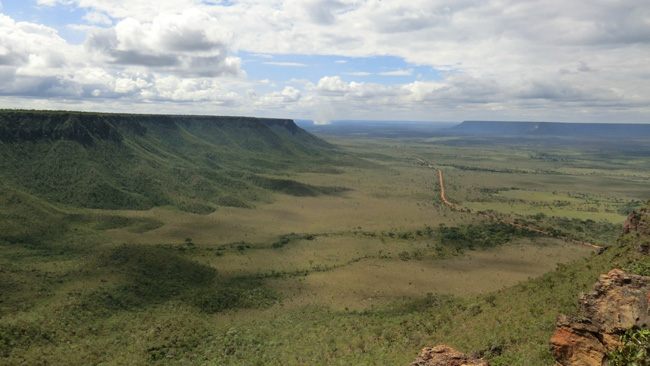
Contributions to and effects on biodiversity conservation
By introducing "ecological corridor," the Company contributed regional scale appropriate management of ecosystems covering an urban area and farmland surrounding the protected areas, and to improve ecosystem continuity.
Examples of efforts by private sector
The Company implemented the “Jalapao Region Ecological Corridor Project”
in the Brazilian savanna called “Cerrado.” The Company engaged in the development of ecological corridors that connects protected areas and their surrounding ecosystems, including farmland and forests, through creating an institutional mechanism for appropriate management of the nature.
SHIMIZU CORPORATION / Urban Ecosystem Network Evaluation
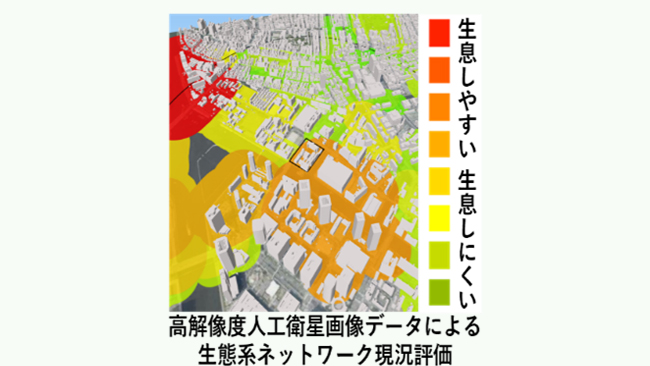
Contributions to and effects on biodiversity conservation
Using high-resolution satellite data, we extract and classify green areas in an urban environment and map the habitability of living things (habitat suitability) in high definition according to such as grasslands, forests, and waterside to assist new landscape design.
Examples of efforts by private sector
・Recovery of urban ecological networks through the evaluation technology
・Analysis technology that foresight biodiversity in landscape design
・Visualization of corporates’ contributions for biodiversity
Oji Holdings Corporation
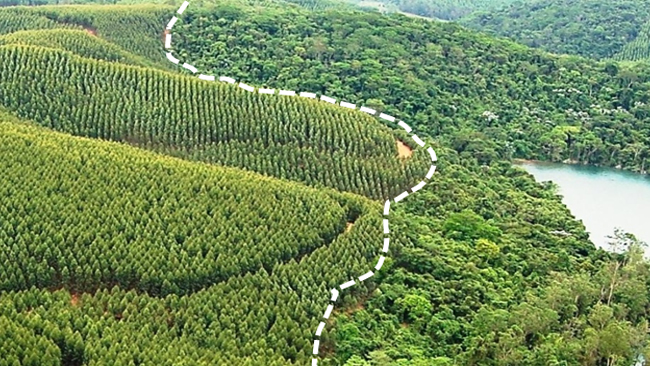
Contributions to and effects on biodiversity conservation
・Maintain forest area through sustainable forest management
・Provide habitat for both grassland organisms and organisms that prefer mature forests by maintaining both young and mature forest plantations within the same region.
Examples of efforts by private sector
Oji Group's purpose is “Grow and manage the sustainable forest;Develop and deliver the products from renewable forest; and Oji will bring this world a brighter future filled with hope.”
With the recognition that company-owned forest is important natural capital which forms basis of our business, we aim to prevent its decline and attempt to increase it. We implement sustainable forest management that reconciles timber production with biodiversity conservation as follows.
・Basic policy for forest management
Oji group owns and manages 603,000 hectares of forests in Japan and overseas, and actively utilizes the forest certification system to conduct appropriate forest management while considering the environment, society, and economy. Additionally, the forest certification acquisition rate is 94% for overseas plantations and 100% for domestic company-owned forests (as of the end of fiscal 2022).
Out of the 603,000 hectares of Oji Forest, 455,000 hectares are production forests whose main purpose is to produce timber while being environmentally friendly, and 148,000 hectares are conservation forests whose main purpose is to conserve biodiversity and watersheds. When managing production forests, we keep a thorough cycle of planting trees, growing them, felling them, and then replanting them, based on the idea that “those who use trees have an obligation to plant them.” This sustainable management method maintains both young and mature plantations within the same region, providing habitat for grassland organisms that prefer young plantations and organisms that prefer mature forests.
Particularly in Japan, previous research showed that over 90% of grasslands that had been maintained for over 100,000 years have disappeared over the past 100 years (see reference URL (1) below). It is thought that our forest management plays an important role for conservation of grassland organism.
JFE Holdings, Inc.
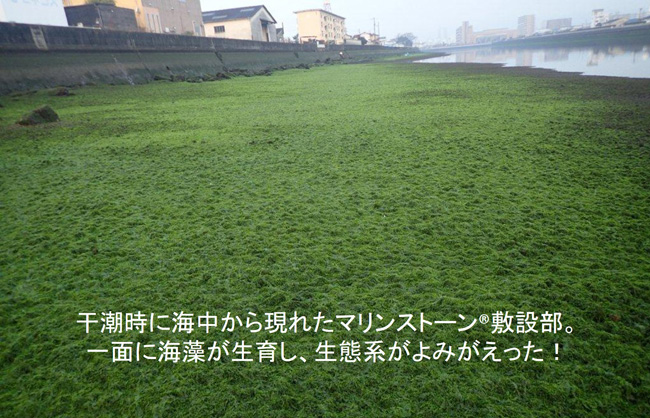
Contributions to and effects on biodiversity conservation
By chemically absorbing sulfuric and phosphorus ions that leach out from sediments, Marine Stone™ can improve the water and sediment quality of tideland areas so that the environment there can be made habitable for wildlife. In addition, as it has a higher density than natural stones, Marine Stone™ has better stability against tidal currents and waves, and therefore, it can also be used as a material of adnation and coadnation bases for benthic organisms and large seaweeds.
Examples of efforts by private sector
Marine Stone™, a granularity-controlled slag product, suppresses the generation of hydrogen sulfide from silty sediments in enclosed coastal seas and improves habitats for marine organisms. Marine Stone™ was adopted for the “Fukuyama Harbor-Port and Harbor Waters Environment Creation Project (Inner Harbor Area) ,” carried out by Hiroshima Prefecture in FY2015, with 38,000 tones of Marine Stone™ used as a bottom sediment improvement material. The effects of Marine Stone™ have continued until now.
NIPPON STEEL CORPORATION
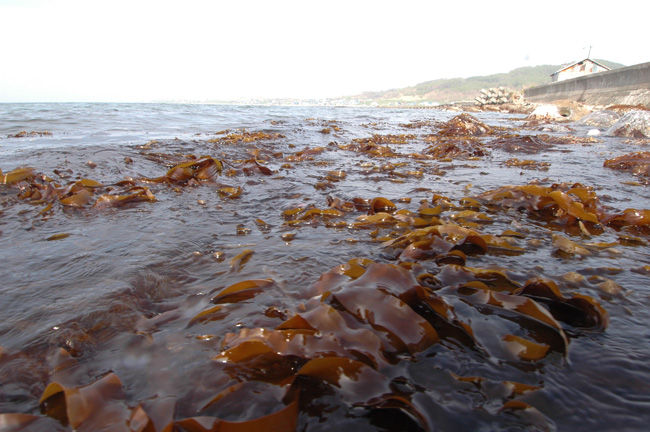
Contributions to and effects on biodiversity conservation
The Company contributes to regeneration of lost seaweed beds by artificially generating and supplying iron humic acids (iron ions) through the installation of the VivaryTM Unit, which supplies iron to sea waters, in sea areas damaged by desertification. A demonstration test started in 2004, and the VivaryTM Unit has so far been implemented in 38 locations across Japan. It has been confirmed that the VivaryTM Unit has the effects of restoring biodiversity through the regeneration of seaweeds and increase in fish catches as a result of biodiversity restoration.
Examples of efforts by private sector
In order to resolve iron shortages in sea waters, which are a cause of sea desertification, the Company has developed the VivaryTM Unit, which is capable of continuously supplying humic acids (iron ions) over a long term, by mixing steel slag, a byproduct of the steelmaking process, with humic soil. It has acquired a safety certification under the JF Zengyoren's safety confirmation and certification system for steel slag products and sells and supplies the product across Japan.
TAISEI CORPORATION / Industrial park development that contributes to nature positivity

Contributions to and effects on biodiversity conservation
1. Effects of tangible factors improvement
Continuous monitoring has confirmed that the forest is making a smooth transition to a natural forest, including the growth of rare species and the transition from grassland to forest species.
2. Effects of intangible factors improvement
A total of 3,528 people have participated in FSPJ activities over the past 10 years, and the number of corporate employee participants has increased significantly (nine times in 10 years), successfully raising corporate awareness of the coexistence with nature.
Examples of efforts by private sector
In this example, a study was conducted to combine tangible and intangible factors to contribute to nature positivity in an industrial park development project in Fujinomiya City, Shizuoka Prefecture, in 2010.
1. Efforts to preserve and create the natural environment from planning to construction stages (tangible maintenance)
By adjusting the height of the building board, we achieved a green area ratio (35%) that significantly exceeds the standard (25%), and we also introduced a “natural forest creation technology” that encourages natural selection among trees.
2. Build a business model that adds value to a scheme for sustainable coexistence with nature (intangible development)
We provide companies that have entered the market with products that add value through sustainable interaction with the local community and the environment (sales of property on the condition that they contribute to the Forest Creation Fund). We also established the “Mt. Fuji Nanryo no Mori Forest Saver Project (FSPJ)” scheme in collaboration with industry, government, academia, and citizens, and provided various forest activity programs to companies and residents for more than 10 years after completion.
ANA HOLDINGS INC. / Efforts of the coral conservation program “Team Churasango” in Onna Village, Okinawa Prefecture
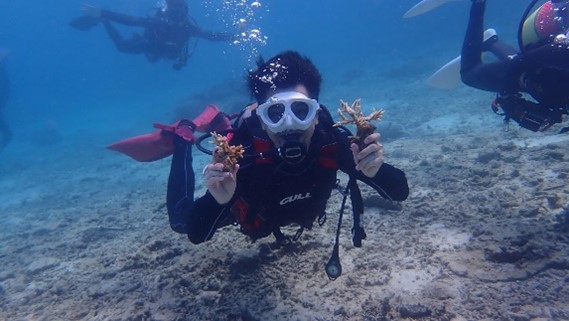
Contributions to and effects on biodiversity conservation
Conservation of marine environments and ecosystems through coral conservation and restoration
Examples of efforts by private sector
In 2004, ANA and nine other companies in and outside Okinawa Prefecture established Team Churasango, and began activities to support coral conservation activities of the Onna Village Fisheries Cooperative in Manza Bay, Okinawa Prefecture. The Onna Village Fisheries Cooperative uses coral collected from the waters of Onna Village as donors to grow coral seedlings, which are planted with a focus on Acropora japonicum, Acropora acropora, Donei, and Acropora kushihada, which have relatively high survival rates. We conduct periodic progress monitoring while removing edible pests such as Acanthaster and Drupella fragum.
We currently have a total of 17 member companies, and we conduct coral seedling planting programs five times a year with the support of the Ministry of the Environment, Okinawa Prefecture, Onna Village, and other government agencies. In 2024, the team will observe its 20th anniversary, and as of last year 17,839 coral seedlings have been planted thanks to the participations of 4,177 people.
ASAHI YOU.US, LTD. / My bottle that allows you to have fun and be involved in sustainability using unused local biomass materials, etc.

Contributions to and effects on biodiversity conservation
・Contribute to the preservation of the ecosystem by donating a portion of the sales of My Bottle in the Forest Yakusugi to conservation activities on Yakushima.
・Conserve coral, the foundation of the ecosystem, by donating a portion of the sales of My Sea Bottle to coral farming activities.
・By encouraging people to carry their own bottles, we will reduce plastic bottles, which are one of the causes of ocean plastic.
Examples of efforts by private sector
My Bottle uses materials that will surprise consumers, such as Yaku cedar and coral, and is based on the concept of having fun and being involved in sustainability.
Through the sale of "My Bottle in the Forest" made from domestically thinned wood and "My Bottle in the Sea" made from bleached coral, we can: (1) reduce waste by using unused materials, and (2) reduce plastic bottles by carrying my own bottle.(3) We aim to revitalize the economy through the release of products that make use of local unused materials.
Although our products alone cannot achieve great effects, by having consumers who have not yet engaged in sustainability initiatives or who do not know where to start, enjoy using our products, we can encourage them to take a step towards sustainability.
Leave a Nest Co., Ltd. / LVNS Forest Project
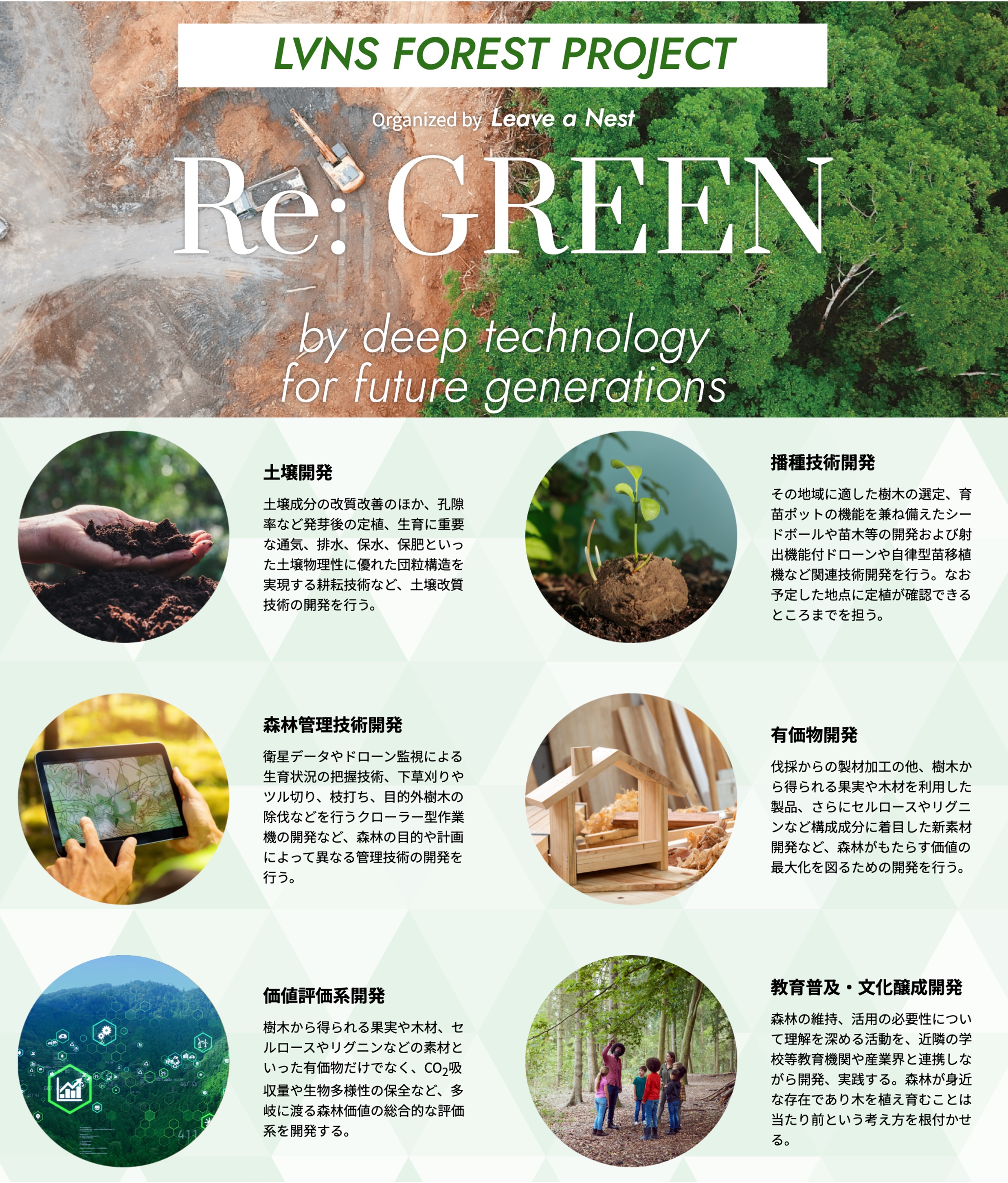
Contributions to and effects on biodiversity conservation
This project will contribute to the increase of biodiversity through the development of effective reforestation technology, sustainable acquisition of valuables, and the development of technology to evaluate these resources. In Mindanao Island in the Philippines, one of our fields, bare lands of former mines are still remaining, and reforestation there is of great significance for increasing biodiversity.
By proceeding with each project while taking into account its sustainability as a business, we aim to create biodiversity-conscious products and services from each partner company.
Examples of efforts by private sector
The "LVNS Forest Project" wase launched in March 2022 with the aim of inventing an economic system to regenerate, manage, and use forests and a new social system, including cultural development, through a collection of technologies, and to envision a new form of symbiosis between forests and people. We have forged a partnership with 12 Japanese corporates and Galansiyang Inc., which is involved in reforestation in the Philippines, and proceeding projects as developing seeding drones for afforestation, seed balls, and more.
We also are in discussions for field installation with the Philippines Forest Management Bureau, Ecosystems Research and Development Bureau and local mining companies.
Under this project, we will continue to involve startups, academic researchers, and corporates with related technologies to form projects in six themes: soil development, seeding technology development, forest management technology development, valuables development, valuation system development, education and cultural development.
Japan Transocean Air (JTA) / Coral restoration project by enhancing sexual reproduction
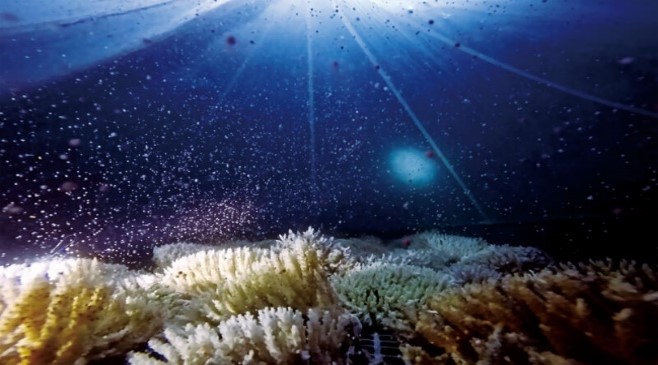
Contributions to and effects on biodiversity conservation
Conservation of marine environments and ecosystems through coral conservation and restoration
Examples of efforts by private sector
In 2020, Japan Transocean Air established the "Sexual Reproduction and Coral Restoration Support Council " together with Fisheries Infrastructure Development Center and others. JTA has helped in financial support, creation of public relations magazines, recruiting support companies, and coordination of 9 sponsoring companies. The Sexual Reproduction Method means mass production of coral seedlings from coral eggs by the Fisheries Agency in 2018 but requires a high level of technical expertise. Under the 6-year support plan, JTA will provide technical guidance to the Yaeyama Fisheries Cooperative Association in Ishigaki City, Okinawa Prefecture, so that its coral regeneration activities can run on their own, while also working expand the area. In addition to the Yaeyama area, we have started this activity in the Kumejima area in 2022. In the future, we would like to develop programs for children's experience and education, etc., and accept inspection tours to make our activities widely known and to expand our circle of support.
ASAHI KASEI CORPORATION
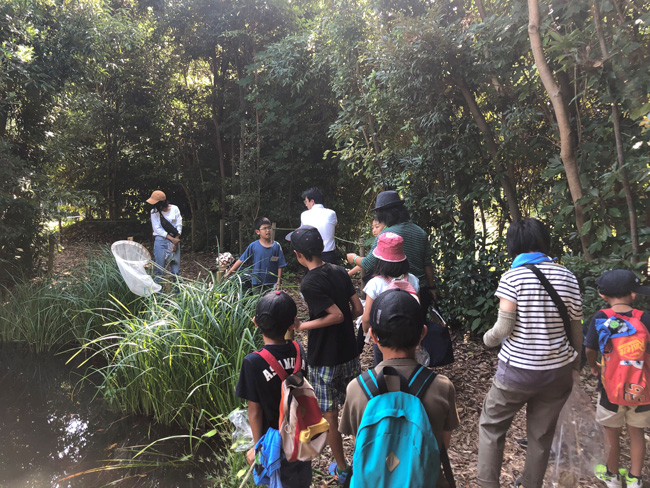
Contributions to and effects on biodiversity conservation
The Company contributes to raising awareness among local residents about biodiversity conservation through the conservation of satoyama areas.
Examples of efforts by private sector
The Company has regenerated satoyama areas at former factory sites and is conducting conservation activity together with local residents. The Company increases the value of green areas and enhances employees' understanding and awareness about biodiversity conservation by planting native species of trees on the premises of factories and promoting nature observation.
Oji Holdings Corporation /
Sustainable forest management that reconciles timber production with biodiversity conservation
Identification of areas important for biodiversity conservation within company-owned forests and conservation activities
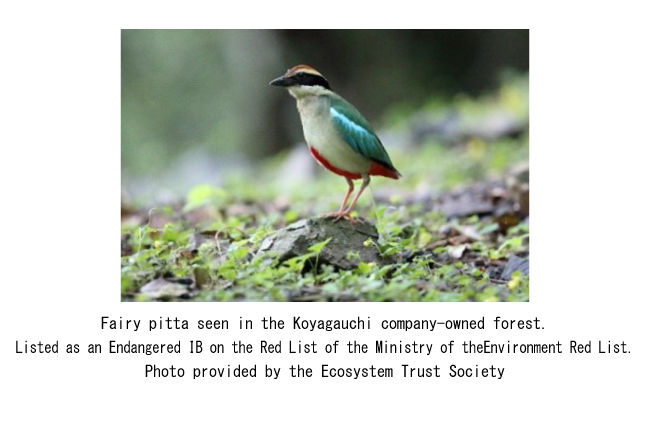
Contributions to and effects on biodiversity conservation
・Conservation of rare species and prevention of extinction
・Development and consideration of quantitative assessment methods for biodiversity
Examples of efforts by private sector
Oji Holdings identifies the areas in company-owned forests that are important for biodiversity conservation and works with residents to conserve wild animals. For example, in the Koyagauchi forest in Kochi Prefecture, we are working with the Ecosystem Trust Society to conserve habitat of Fairy pitta and have currently applied for registration as OECM, which is being examined. Additionally, in 2009, we established the Sarufutsu Itou Conservation Council in collaboration with local conservation organizations, local governments, and researchers, with the aim of conserving Sakhalin taimen that inhabits Hokkaido's Sarufutsu company-owned forests and its river areas, and continue conservation activity. Oji Holdings and the Sarufutsu Itou Conservation Council continue to work to maintain healthy riparian forests of the Sarufutsu River which nurture insects and small fishes that serve as food for the fish, and supply fallen trees that are used as hideouts. We are also engaged in awareness-raising activities such as holding symposiums on the ecology of Sakhalin taimen and providing environmental education to university students. Furthermore, we have started considering monitoring and quantitative assessment of biodiversity with cutting-edge technologies such as audio, drone, and image analysis for the forests that have high priority for conservation chosen by biodiversity potential analysis of company-owned forests across Japan based on current vegetation maps, etc.
Komatsu Ltd.
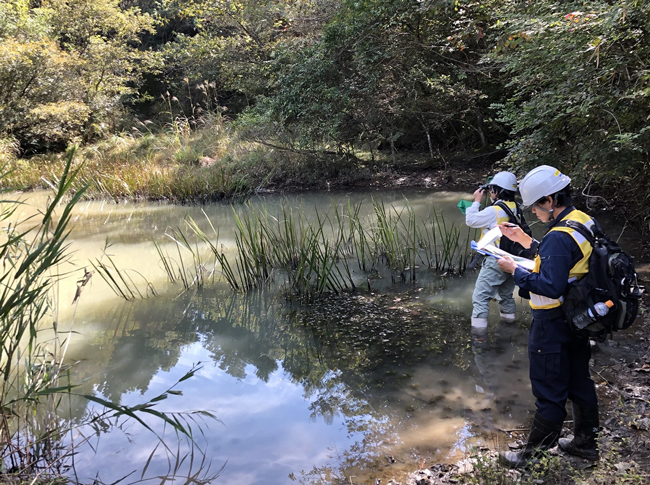
Contributions to and effects on biodiversity conservation
The Company engages in a broad range of activities related to biodiversity conservation as part of its social contribution activity.
Examples of efforts by private sector
○ Biodiversity friendliness regarding the use of land: Conclusion of the "Osaka Biodiversity Partner Agreement" (since 2016) at the Osaka factory
Under the agreement, the Company can expect to contribute to the local community and to generate spillover effects, such as an increase in awareness about biodiversity, by establishing an ecological network through biodiversity-friendly management of the green space (Komatsu satoyama) on the premises of the Osaka factory and by using the area as a field of nature observation for citizens.
○ Ecosystem conservation: " Biological Survey (since 2011)" at the Test field
The Company has made the environment more habitable for rare native endemic species of local amphibians by improving forest areas and developing reservoirs of high-quality water into a biotope. To ensure that how favorable the environment is, the Company also conducts surveys to identify the numbers of egg masses and sexually mature individuals during spawning seasons. It has been confirmed that the number of individuals rose following the conservation activity.
Suntory Holdings Limited.
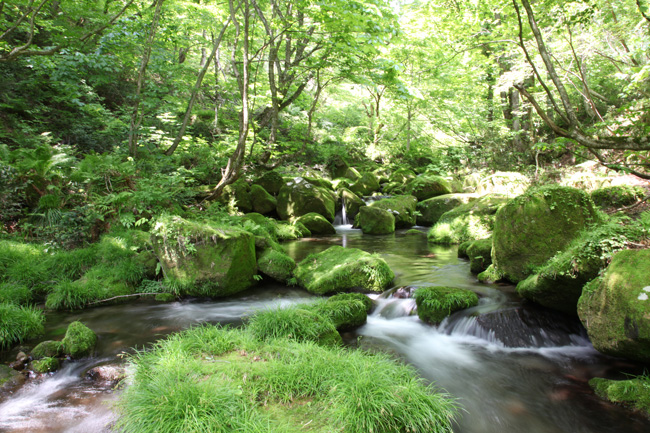
Contributions to and effects on biodiversity conservation
Through sustainable forest management, the Company can contribute to maintaining forests' multi-faceted functions and conserving rich biodiversity.
Examples of efforts by private sector
Natural Water Sanctuary Initiative -- For the future of water and life: Aiming to ensure the sustainability of water resources, the Company started the Natural Water Sanctuary in 2003 under the goal of enhancing water source areas' water-retaining function and conserving biodiversity. At forests in areas used by the Company’s factories as water-retaining areas, the Company is cultivating water resources in forests which is more than twice the amount of water used by our plants.
Shimizu Corporation
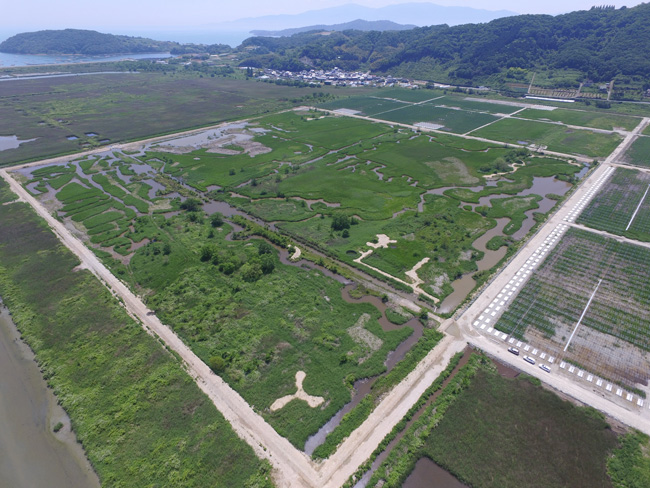
Contributions to and effects on biodiversity conservation
The Company revived a marsh by linking existing and new creeks to creat an environment that takes advantage of waterside spaces and indigenous plants.
Examples of efforts by private sector
The Company designated 46% of the premises of a solar power plant as a natural environment conservation zone and developed 16 hectares of the area as the "Kinkai habitat" biodiversity conservation space in order to reconcile solar power development and ecosystem conservation. The Company aimed to improve the feeding environment for birds of prey using existing clumps of trees and reed bushes for the purpose of conserving the rare birds by linking scattered waterbodies via creeks in line with the original topography of the site. The design, creation of a complex waterside space with varied water depths, vegetation based on indigenous plants, and an environment favorable for small animals, is expected to lead to an increase in the populations of birds and mice as food source of them.
Sumitomo Forestry Co., Ltd.

Contributions to and effects on biodiversity conservation
By conducting forest management appropriately, it is possible to maintain forests' functions that serve public interests while making use of wood resources.
Examples of efforts by private sector
The Company owns approximately 48,000 hectares of forests in Japan (equivalent to one-eight hundredth of the entire territorial land of the nation) and has acquired forest certification for all the forests area under the SGEC Japanese forest certification system, which is mutually recognized with the PEFC. Having compiled and distributed the list of endangered fauna and flora Red Data Book, the Company educates those who engage in the forests operations to ensure proper management.In waterfront area, home to various wildlife, the Company ensures appropriate management with the Riparian Forest Management Manual.
Daiwa House Industry Co., Ltd.
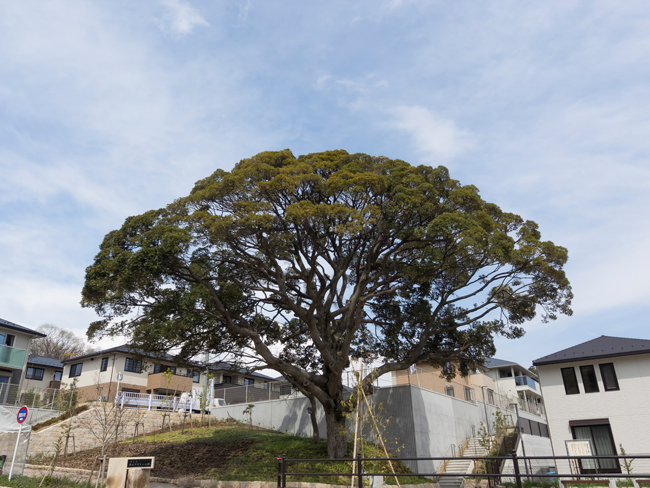
Contributions to and effects on biodiversity conservation
The Company contributes to the conservation of green areas through the monitoring of ecosystems.
Examples of efforts by private sector
Before the development of Tama Hills, the Company closely examined the local ecosystem, confirmed the presence of a food chain with birds of prey at the top and 1,807 species of plants and animals, and secured the conservation of rare species by resettlement. With biodiversity conservation as a town development theme, the Company conducted monitoring of the ecosystem and checked the conservation situation once or twice a month during construction period and for one year after the completion of construction. A third of the entire project area (11 hectares) was conserved as green areas without development. The Company developed a corridor greenbelt, adopted native species of trees for planting and created a biotope.
Hitachi, Ltd.
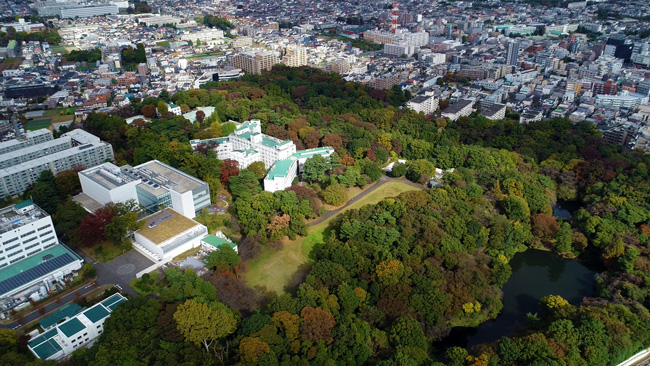
Contributions to and effects on biodiversity conservation
The Company contributes to appropriate management and conservation of company-owned forests, including river ecosystems.
Examples of efforts by private sector
In cooperation with Tokyo Gakugei University, the Company conducts the monitoring of river ecosystems using the environmental DNA technology on the premises of its research institute. The Company contributes to the formulation of measures to protect the river ecosystem by detecting living organisms' DNAs that exist in the river water in a miniscule amount, estimating the species that live in the river and making the habitat situation visible.
MITSUI & CO., LTD.

Contributions to and effects on biodiversity conservation
Through sustainable forest management, the Company can contribute to maintaining forests' multi-faceted functions and conserving rich biodiversity.
Examples of efforts by private sector
The Company owns and manages a total of 44,000 hectares of forests at 74 locations across Japan and has acquired both the FSC and SGEC certifications. The Company classifies its forests into "Harvest-oriented Sustainable Cycle Forests," "Natural Restoration Forests," "Biodiversity Conservation Forests," "Productive Naturally Regenerated Forests," "General Naturally Regenerated Forests" and "Other Naturally Regenerated Forests" and individually sets management policies for these categories of forests. "Biodiversity Conservation Forests" account for around 10% of the total. The company conducts ecosystem monitoring for rare species in the forests.
SUMITOMO FORESTRY CO.,LTD. / Building a “Conservation Network” for landscape-level ecosystem conservation in Indonesia
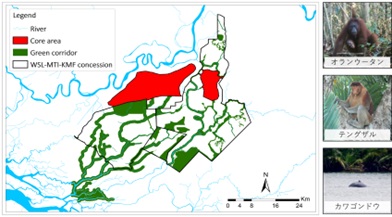
Contributions to and effects on biodiversity conservation
・The boundaries of the business area determined by the authority do not necessarily match the boundaries of the ecosystem.
Conservation network is to ensure that the habitats of rare animals such as orangutans and proboscis monkeys that live within the concession area are not fragmented into patches.
We work with governments, companies, and local communities around our concessions to manage valuable ecosystems at the landscape level.
Also, upon the start of the project, the concession areas were assessed with the advice of IFC, in accordance with the concept of "High Conservation Value Forest (HCVF)". In line with this approach, biodiversity balance and local community’s livelihood were assessed and reflected in our business plans.
In addition to the terrestrial life, we also conduct surveys of aquatic life in the rivers that flow through the area, and the inhabitation of rare animals such as the river dolphin has been confirmed.
We are working to preserve the ecosystem, considering the impact not only within the business area but also downstream.
Examples of efforts by private sector
At forestry project sites in Indonesia, we establish protected areas, buffer zones, and afforestation areas after conducting flora and fauna surveys not only within the project site but also in adjacent government-managed conservation forests. In consultation with neighboring companies, we are building a conservation network that creates a network of green corridors. We also work to maintain a balance between economic activity, the environment and social aspects by monitoring illegal logging and population of rare animals, and providing awareness-raising activities for local residents.
ANA Akindo Co., Ltd. / ANA “Farm Project”
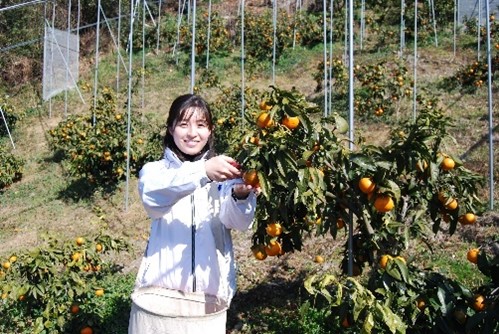
Contributions to and effects on biodiversity conservation
・Restoring farmland by regenerating abandoned farmland
・Soil activation
・Preventing the occurrence of pests and weeds, the invasion of wild animals such as damage from birds and animals, and the deterioration of disaster prevention functions in the event of floods and fires
Examples of efforts by private sector
ANA “Farm Project” is ANA Akindo's entry into the farm business to build a business model for regional revitalization by regenerating and utilizing “abandoned farmland”which is one of the problems faced by farms (primary sector of industry). First, the Matsuyama branch will work on solving various problems faced by mandarin orange farms in Ehime Prefecture as part of the “Project to protect the future of mandarin orange farms in Ehime in the future”. It will also target farms and cultivated land other than mandarin oranges and eventually the agriculture, forestry, and fisheries industry. This is a project that allows for horizontal expansion across the board.
・Registered “Iyokan tree ownership system” on ANA's hometown tax donation portal site (Matsuyama City)
・Desserts using Iyokan will be served as in-flight meals on ANA domestic flights in premium class
・Ranked 1st in a survey of 100 ANA flight attendants Sales of “100% straight fruit juice mixed with Iyokan and Shiranui”
・ANA's crowdfunding "WonderFLY" is seeking support for maintenance costs for abandoned farmland and purchase costs for mandarin orange seedlings.
SHIMIZU CORPORATION / Regeneration Forest Biotope
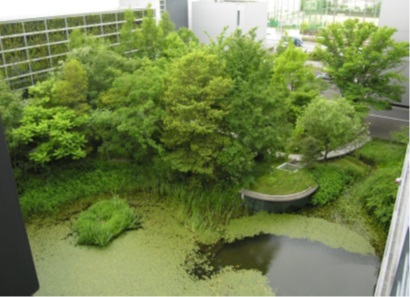
Contributions to and effects on biodiversity conservation
・Recovery of biodiversity in urban areas
・Model case of green spaces related to foresight biodiversity
・Accumulation of data, information, and knowledge and its evolvement
・Provide opportunities for environmental education, tours, and so on to ripple effect to other places
Examples of efforts by private sector
Intending to regenerate the relationship between people and living things in urbanized areas, we integrate with the local community by creating high-value-added green spaces.
The biotope regenerates local greens by planting native species, including buried seeds. It also contributes to the regeneration of urban natural ecosystems; the preservation of endangered species and resource circulation by reusing excavated soil and composting pruned branches and fallen leaves.
Kirin Holdings Company, Limited / Restoring biodiversity and the Satochi-Satoyama environment through Chateau Mercian Wanko Vineyard to expand the Japanese wine business.
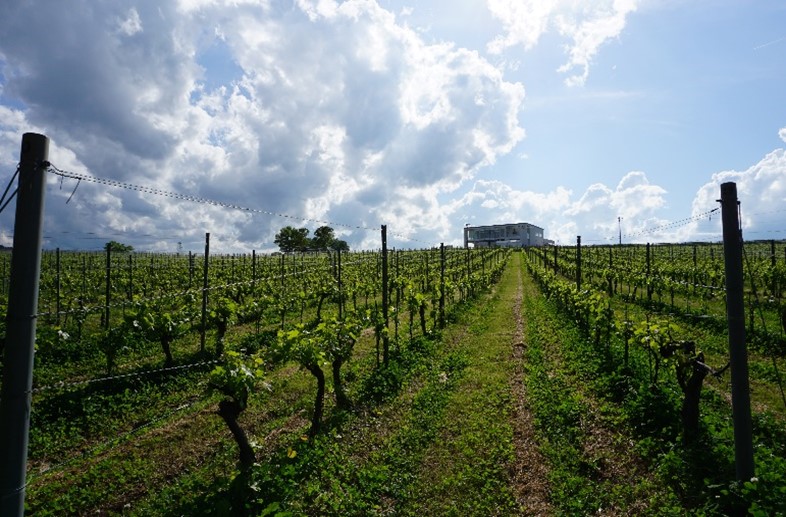
Contributions to and effects on biodiversity conservation
By regularly mowing the underbrush for grass cultivation, the field functions as a high-quality, vast grassland, creating an environment where native and rare species can grow without allowing plants with strong reproductive power to become dominant.
(Grassland environments, which are decreasing significantly in Japan, can be created, and maintained through management through viticulture.)
Examples of efforts by private sector
Biodiversity has been restored by converting idle and degraded land, which had been a regional issue, into a grass-cultivated vineyard for Japanese wine, and by continuing grape production. A joint study with the National Agriculture and Food Research Organization (NARO) has scientifically proven that grass-cultivated vineyards create high-quality, vast grasslands. It is an example of realizing “nature positivity.” Together with the local community, volunteers, and employees, we are also conducting activities to increase the number of native species.
Sompo Japan Insurance Inc. / 100 OECMs project
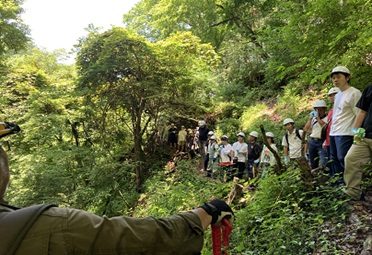
Contributions to and effects on biodiversity conservation
・We aim to make the green within our premises nature positive by incorporating plants that are compatible with indicator species for birds and insects in nearby protected areas, etc. in the green space created through recent exterior construction work.
・We will focus on connectivity with ecological sites in the area where we are located, such as Shinjuku Gyoen National Garden near our Shinjuku headquarters, and proceed with a bird's-eye view of biodiversity and urban development that goes beyond our own site.
・Plans to incorporate the idea of NbS (Nature-based Solutions) into existing green and encourage understanding from stakeholders and the participation of in-house nature lovers (e.g. honey production in Japanese beehives).
・SOMPO Forests (*), where employees across the country carry out forest maintenance activities, collaborates with local governments and involves local companies, financial institutions, and civil society to promote OECM and raise awareness. (*The Sompo Chikyu (Earth) Club, a volunteer activity organization of which all group employees are members, plays a pivotal role in conducting volunteer activities throughout Japan.Since its establishment in 1993, the Club is undertaking various activities including forest conservation, cleanups, cleaning and maintenance of wheelchairs in welfare facilities, and collection of second-hand books by collaborating with agencies. )
・The SAVE JAPAN Project started in 2011, after CBD COP 10 took place in Aichi, Japan, and has over 10 years of history in partnership with Japan NPO Center, regional NPO support centers, and local environmental groups. We have succeeded in conserving 300+ endangered species across the nation with a total of 62,000+ multi-stakeholders’ participation. In the new phase of Save Japan Project, we will support projects that contribute to the penetration and promotion of Eco-DRR and OECMs, to achieve nature-positive effects.Thus, we will show the world a model that P&C insurers can be a driving force in promoting the spread of OECM, since disaster prevention and mitigation is the mission and primary business of P&C insurers.
Examples of efforts by private sector
Sompo Japan aims to register 100 OECMs by supporting OECM applications for conservation activities involving companies, local governments, NPOs and civil society, in addition to its own premises, to promote Eco-DRR (Ecosystem-based Disaster Risk Reduction).
The SAVE JAPAN Project (*), launched in 2011, revised the policy to support projects that contributes to the promotion of Eco-DRR and OECMs. (*Sompo Japan Insurance asks our customers to consider choosing web-based policies or terms and conditions when they purchase automobile insurance. The cost savings are used to fund biodiversity conservation projects called “Save Japan Project”.)
The increasing frequency and severity of natural disasters due to climate change is a major social issue. For P&C insurers, in addition to the financial function of compensating for economic losses, disaster prevention and mitigation efforts will lead to the sustainability of local communities and the stability of the insurance business, which is social infrastructure.
Thus, we will show the world a model that P&C insurers can be a driving force in promoting the spread of OECM, since disaster prevention and mitigation is the mission and primary business of P&C insurers.
Japan Airlines Co., Ltd. / Beach Clean-up
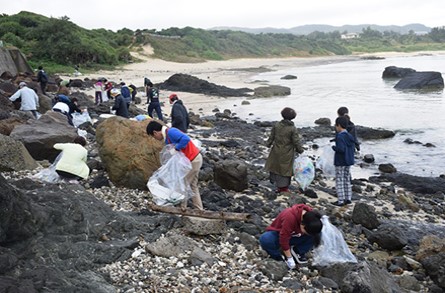
Contributions to and effects on biodiversity conservation
Protection of natural environment by means of beach maintenance
Examples of efforts by private sector
Japan Air Commuter, JAL Kagoshima Branch, Japan Transocean Air, and Ryukyu Air Commuter are protecting the natural environment together with locals by holding beach clean-up activities. In 2019, in both the Okinawa region and the Kagoshima region, we joined local businesses and organizations to establish the World Natural Heritage Promotion Collaborative Joint Venture and Community. The strengths of over 30 participating companies and organizations, are used effectively to promote the protection of the natural environment and the regional development utilizing nature.
NTT DOCOMO, INC. / NTT PC Communications Incorporated

Contributions to and effects on biodiversity conservation
Through measures using ICT, the Companies can reduce conflicts between people and wildlife as well as bird and animal damage to agricultural products even with small manpower.
Examples of efforts by private sector
As part of activity to reduce bird and animal damage, the Companies provide a system using a magnetic sensor and an infra-red camera to detect the presence of wildlife caught in traps (game). In order to promote the use of trapped wildlife as food (game meat), the Companies are also developing a sales-matching system linked to identification information regarding individual animals and birds thus caught. The Companies have already provided solutions for mitigating bird and animal damage to more than 80 local governments, and this activity has led to the acquisition of domestic game certification and sales of game meat.
Takeda Pharmaceutical Company Limited.
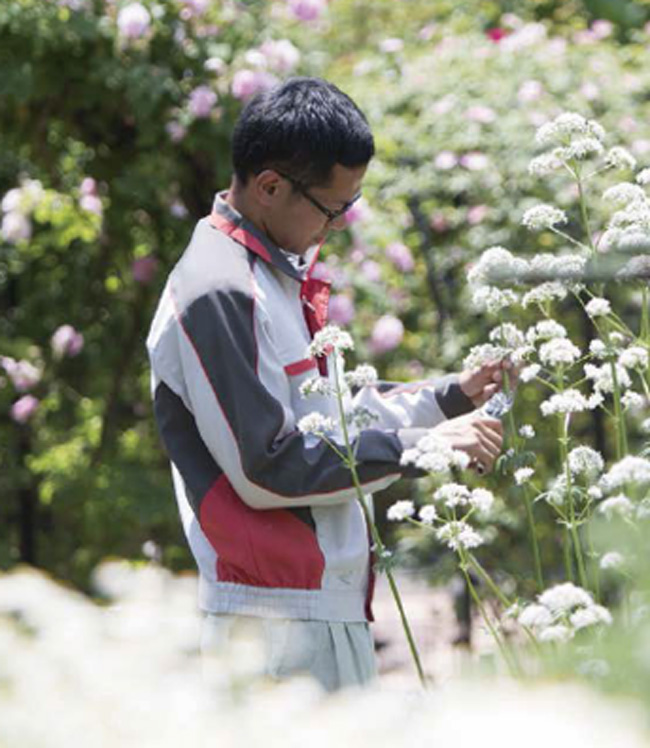
Contributions to and effects on biodiversity conservation
The Company can contribute to collecting and conserving important medicinal and other useful plants, including endangered species, by taking advantage of its plant cultivation technology.
Examples of efforts by private sector
The Company operates the Takeda Garden for Medicinal Plant Conservation , owns and cultivates around 2,800 species of plants, mainly medicinal plants, and strives to collect and conserve important medicinal and other useful plants, including endangered species. As part of its education support, the Company also continuously implements the Wakuwaku Shizen Fureai Team experience program for pupils and parents of neighboring elementary schools.
FUJITSU LIMITED
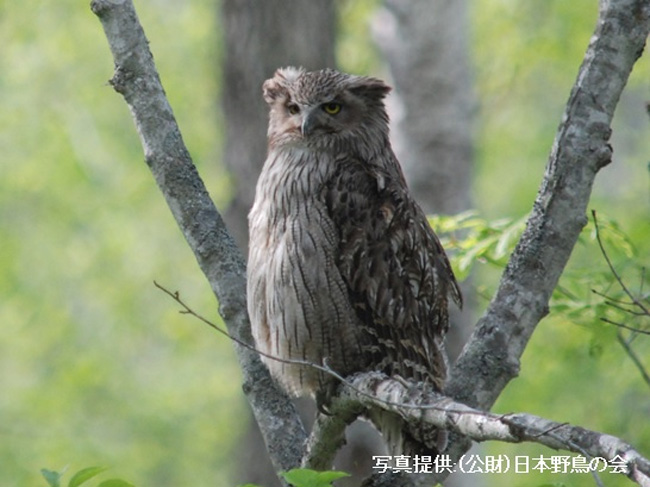
Contributions to and effects on biodiversity conservation
The Company's voice recognition software has significantly reduced analysis time by automatically identifying hoots of the Blakiston's fish owl. The software enables the collection of information necessary for habitat conservation with small manpower and at low cost. As a result, it makes it easier to increase survey locations and find new habitats, contributing to expanding the size of the conservation area.
Examples of efforts by private sector
The Company has provided voice recognition software to the Wild Bird Society of Japan, which conducts habitat surveys in order to conserve the Blakiston's fish owl, an endangered species that lives in Hokkaido. Previously, the method of checking the presence of the Blakiston's fish owl was listening to recorded data or visually observing voice spectrums. However, the Company's ICT and AI technology was introduced in order to automatically identify hoots of the Blakiston's fish owl from among recorded data, thereby contributing to the significant reduction of analysis time and the improvement of the accuracy of hoots detection.
KDDI CORPORATION / Realizing Nature Positive empowered by KDDI group Utilizing an on-water drone for monitoring seaweed bed growth
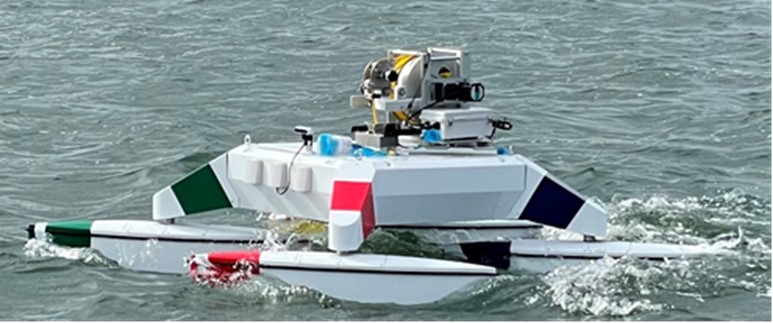
Contributions to and effects on biodiversity conservation
・New technology including an on-water drone introduced enables estimation of the “coverage” - the ratio of seaweed areas, home to aquatic creatures, to a whole picture.
・With the on-water drone, more accurate and firsthand underwater monitoring is possible to identify the variety of seaweed and then estimate the "coverage," which is not always easy for aerial drones.
・An automation system for blue carbon estimation, currently under development, will enable automation of working out the amount of blue carbon based on the estimated variety of seaweed, their volume, and their underwater locations, which are derived from machine learning on data collected with an underwater camera sensor device.
・A new value chain for motivating fishing villages will be created, a closer collaboration with companies on more energetic and sustainable activities including seaweed bed conservation applicable to “J Blue Credit” transforming blue carbon into a tradable form.
Note: “J Blue Credit” is the trademark of Japan Blue Economy Association.
Examples of efforts by private sector
This project promotes Ocean DX including increasing efficiency in monitoring seaweed bed growth using an on-water drone and developing an automation system for blue carbon estimation for decarbonization of fishing villages and improved profitability, leading to contribution to stable fishing catches and fishery production.
A field trial was conducted off Suga island (Suga-shima) and Toshi island (Toshi-jima) in Toba, Mie Prefecture, aiming for validating efficient monitoring for the growth of seaweed beds using an on-water drone. The autonomous navigation, one of its features, has been verified working well, following routes set on a smartphone and taking pictures and videos of seaweed beds with an on-board underwater camera at pre-defined points.
Analysis of the photos and videos taken has demonstrated potential to estimate the “coverage” - the ratio of seaweed areas to a whole picture, which is one of the important factors for the blue carbon estimation.
For materializing carbon neutral in the fishing industry and building a profitable business model, a new initiative has been following to develop an automation system for blue carbon estimation making use of machine learning with institutes in Mie Prefecture. Some of the activities include successful seaweed bed growth monitoring using a prototype underwater camera sensor device.
Click here for details (Link to corporate website)
Click here for details (Link to corporate website)
Click here for details (Link to corporate website)
Click here for details (Link to corporate website)
Click here for details (Link to corporate website)
Click here for details (Link to corporate website)
KDDI CORPORATION / Invasive Alien Species Survey Using AI-based Biological Information Visualization App "Biome" and Satellite Communication Technology Starlink.Contributing to biodiversity conservation on Iriomote Island, Okinawa, a World Natural Heritage Site

Contributions to and effects on biodiversity conservation
・In Iriomote Island, a World Natural Heritage site, there is concern about the impact of invasive alien species on the unique ecosystem of Iriomote Island due to their invasion and establishment. In order to survey invasive alien species, an Internet access line was established by "Starlink Business" in an area where mobile communication is unstable, and distribution data of invasive alien species were collected using the smartphone application "Biome".
・Employees from KDDI Corporation, Okinawa Cellular Telephone Company, and Biome, Inc. participated in the survey. The latest name recognition AI in "Biome" determines the species of plants and animals, so even if you are not an expert on plants and animals, you could participate in the survey by simply taking a photo.
・This survey was conducted as part of the "Okinawa Nature Conservation Project," a project that contributes to the protection of the natural environment, in cooperation with the Okinawa Amami Nature Conservation Office of the Ministry of the Environment, the Nature Conservation Division of the Environment Department of Okinawa Prefecture, and Taketomi Town. The data collected from this survey will be shared with the Ministry of the Environment, Okinawa Prefecture, and Taketomi Town, and will be used for environmental protection and measures against invasive alien species in Iriomote Island, thereby supporting biodiversity conservation efforts.
Examples of efforts by private sector
In April 2023, KDDI invested in Biome Corporation, which provides a platform for visualizing biological information, through the KDDI Green Partners Fund which is a corporate venture capital fund that supports startup companies working on environmental issues. In September 2023, KDDI conducted a survey of invasive alien species (hereafter, the "Survey") on Iriomote Island, Okinawa Prefecture, which is registered as a World Natural Heritage site, with the aim of conserving biodiversity there, utilizing Biome's "Biome" living creature collection application and "Starlink Business" satellite communication.
Mitsui Sumitomo Insurance Company, Limited Aioi Nissay Dowa Insurance Co., Ltd. / Insurance products that alleviates negative impacts on natural capital and biodiversity
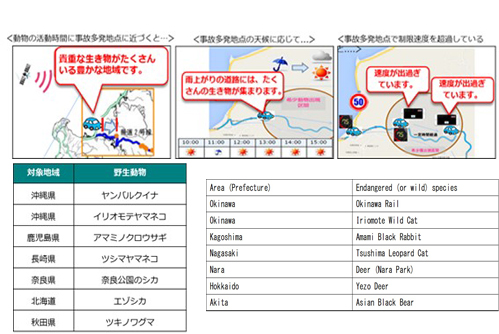
Contributions to and effects on biodiversity conservation
Regarding (1) we are contributing to the prevention of car accidents (road kill), which is one of the top causes of death for endangered species such as the Iriomote wildcat.
Regarding (2) (3)and (4) it goes beyond the scope of traditional insurance coverage, such as the scope of liability, and covers the costs required to restore the environment damaged by pollution and forest fires and helps alleviate the negative impact on the natural environment and biodiversity. Contributing. (For example, compensation for the costs of coral reef protection, early cultivation and relocation, cleaning of mangrove forests, tree planting, etc. due to stranded ships)
Examples of efforts by private sector
・Contribute to the conservation of biodiversity through services that prevent accidents or provide compensation for unforeseen and sudden damage to nature
(1)Reduction Support for Roadkill: Dedicated dashcam for automobile insurance provide animal alert , informing drivers to drive carefully when approaching areas where endangered species inhabit. Currently, the target areas and animals are being expanded as shown in the table below. In addition, donations are made to organizations working on rare animal protection and roadkill reduction based on the sales performance of dedicated dashcam equipped with animal alert.
(2)Additional Compensation for Marine Pollution: Compensate for expenses incurred by ship operators beyond their liability for damages to the natural environment caused by ship accidents, for the purpose of preventing and recovering from expanded damage.
(3)Extended Compensation for Pollution Damage: Broadly compensate for liability for damages and purification costs resulting from unforeseen and spontaneous pollution caused by factories and other facilities.
(4)Compensation for Reforestation and other Expenses: Compensate for the costs associated with reforestation and other expenses that were previously not covered by traditional forest fire insurance.
Oji Holdings Corporation / Sustainable forest management that reconciles timber production with biodiversity conservation Introducing the latest technology to forest management
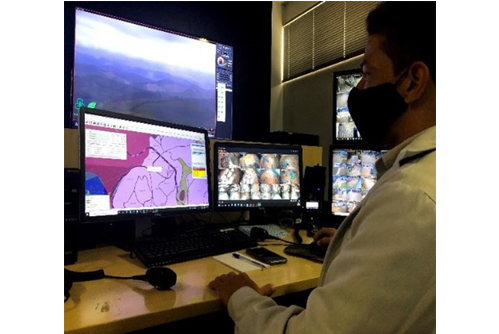
Contributions to and effects on biodiversity conservation
・Reducing the risk of biodiversity degradation by preventing large-scale fires
Examples of efforts by private sector
In recent years, large-scale forest fires have occurred frequently, and there is concern that they may have negative impact on biodiversity which is greater than that of wildfires which had traditionally occurred naturally. CENIBRA, a company that operates plantation management and pulp manufacturing businesses in Brazil, has introduced an innovative fire prevention system that utilizes artificial intelligence (AI) in its 250,000 hectares of forests. The company maintains 38 observation towers in the forest equipped with rotating cameras that cover 360 degrees, and when the AI detects smoke or fire, the closest firefighter is contacted from the monitoring room and promptly extinguishes the fire.
By using an AI-equipped camera that is better than the human eye to determine the location of a fire accurately within 1-2 minutes, it is possible to reduce the risk of forest fires significantly and maintain production forests and biodiversity accordingly.
Japan Airlines Co., Ltd. / Conservation of Red-Crowned Cranes
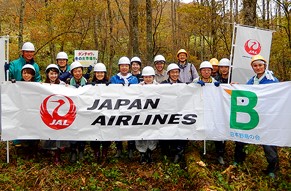
Contributions to and effects on biodiversity conservation
Protection of endangered animals (red-crowned crane)
Examples of efforts by private sector
Once per year since 2016, JAL Group volunteers have been working in Tsurui Village, Hokkaido, to improve the environment of a foraging area for the red-crowned crane, a national natural treasure. With the cooperation of Tsurui Village, Group volunteers help cut down fallen trees and clear branches from the grounds of the Wild Bird Society of Japan to create an environment where the cranes can forage for food and live on their own even in winter (natural winter foraging area), as over 600 cranes visit the village every year as a wintering ground.
Sumitomo Osaka Cement Co.,Ltd.
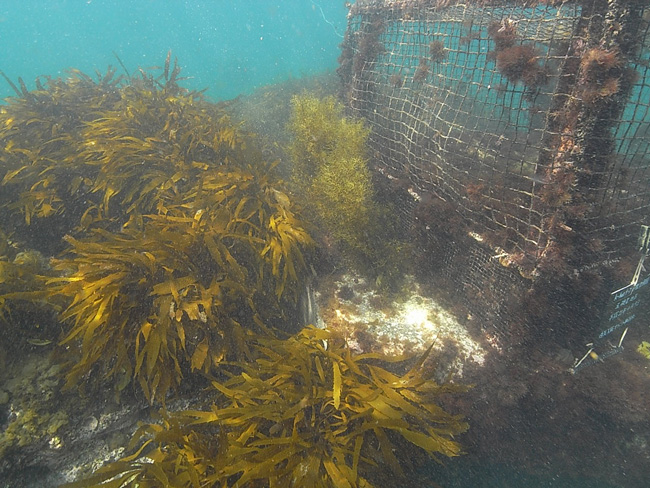
Contributions to and effects on biodiversity conservation
Seaweeds grown in the K-hat Reef Beta reef function as "core seaweed beds" that supply seaweed seeds, thereby contributing to the regeneration and conservation of seaweed beds. It is also possible to provide the function of breeding spiny lobsters and abalones. In addition, the fish attracting function of the "Hybrid Artificial Marine Reef Super SK1300S" can be used to increase resources while preventing overfishing.
Examples of efforts by private sector
As a means to prevent sea desertification, since 2004, the Company has developed the K-hat Reef Beta multi-function seaweed-growing reef, which comprises multiple patented technologies and original knowhow, and operated a business using the artificial reef. The Company also operates a business using the "Hybrid Artificial Marine Reef Super SK1300S," which is composed of an original structure 20 meters high that has been designed based on fish habitat research so as to encourage a great variety of fish, both large and small, to stay.
TAIHEIYO CEMENT CORPORATION
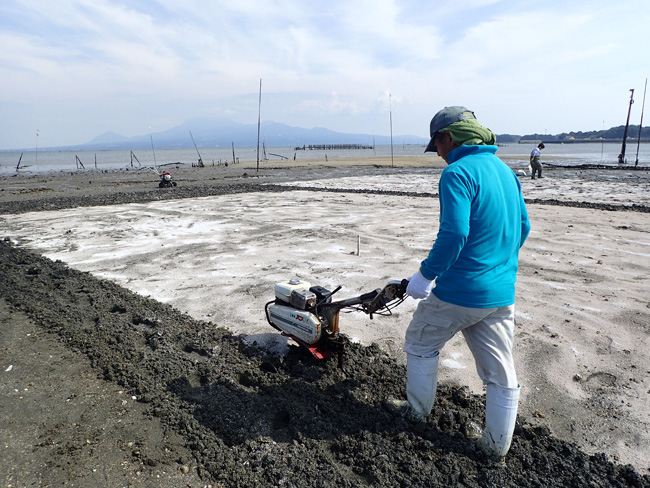
Contributions to and effects on biodiversity conservation
The use of the CERALEAN water purifying compound in farming ponds and tideland areas improves the pH level of sediments and promote the breeding of diatoms, realizing the productivity improvement of shrimp farming (survival rate: up from 37.5% to 61.7%) and the regeneration of a sound tideland environment (survival rate of asari clams: up from 40% to 93%).
Examples of efforts by private sector
The Company sells the CERACLEAN water purifying compound. There are many cases in which the compound was used to restrain the deterioration of the water and sediment quality and improve the breeding environment in domestic and overseas farming areas. In cases of the use of the compound in natural tideland areas, it was confirmed at several areas that the compound has the effect of improving the tideland environment, including the sediment quality and the survival rate of asari clams.
Azbil Corporation
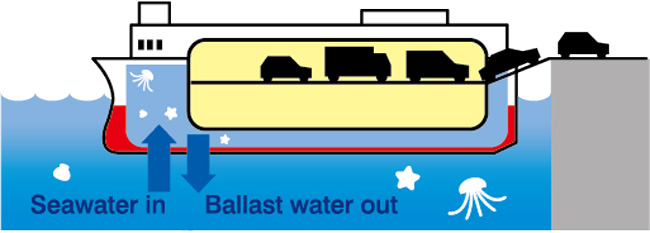
Contributions to and effects on biodiversity conservation
The Company can contribute to the conservation of marine environments by preventing cross-border movement of non-native species of organisms contained in ballast water by providing products and engineering services used for ballast water treatment systems.
Examples of efforts by private sector
Regarding ballast water treatment systems, the installation of which has become mandatory for large ships under the Ballast Water Management Convention, the Company provides solutions using knowledge and knowhow acquired through its ship-related business and products that meet ship-related certification requirements.
Duskin Co., Ltd.
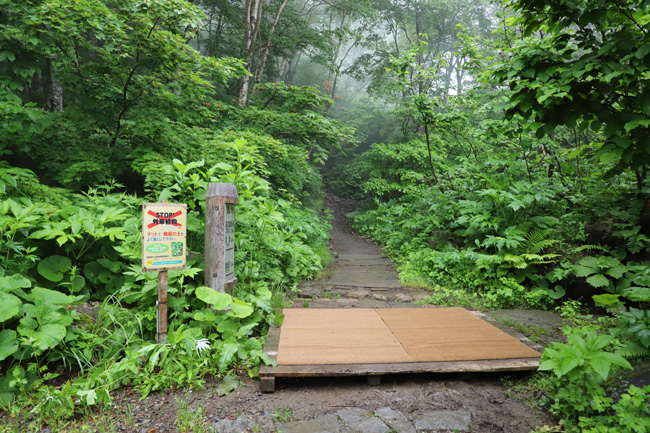
Contributions to and effects on biodiversity conservation
The Company contributes to the conservation of habitats for native species of alpine plants and unique ecosystems by preventing the introduction of seeds of non-native species of plants.
Examples of efforts by private sector
Mats manufactured by Duskin are installed at the entrances of and over the mountain trails at Hakusan National Park in order to prevent intrusion by non-native species of plants. Some positive results of the use of the mats have been confirmed. For example, the presence of seeds of non-native species of plants in soil and sand caught by the mats was confirmed.
Taikisha Ltd.
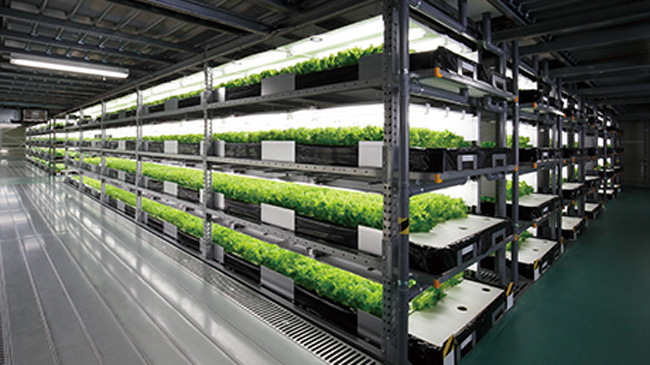
Contributions to and effects on biodiversity conservation
It is possible to produce agricultural products without using any agrochemicals because the closed space keeps out pests and germs. It is also possible to significantly reduce water usage in the water-washing process.
Examples of efforts by private sector
The Company is operating fully artificial lighting plant factory business based on its air conditioning control technology. It has realized the world's only mass production of crisphead lettuces at a full artificial-lighting, water cultivation plant factory capable of accurately controlling light, temperature, humidity, and nutrient solutions and conducting cultivation best suited to plant physiology.
TOYO RICE CORPORATION
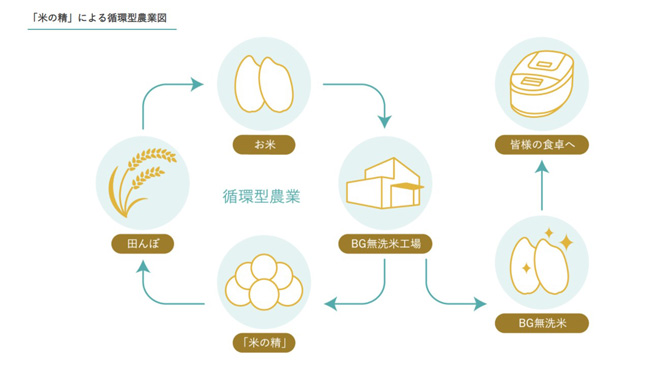
Contributions to and effects on biodiversity conservation
The Company's rice processing system curbs the discharge of pollutants contained in Togijiru (Rice Rinsed Water), leading to the prevention of water quality deterioration. In addition, it contributes to the improvement of the soil environment by producing organic fertilizers as a byproduct.
Examples of efforts by private sector
The Company processes rice skin bran, an ingredient of Togijiru which is removed during the milling of rinse free rice. This promotes soil activity and contributes to the production of delicious crops. The Company also produces the world's only rinse free rice, which has made recycling agriculture feasible.
Smileyearth Corporetion / Local resource circulating towel manufacturing ecosystem technology.
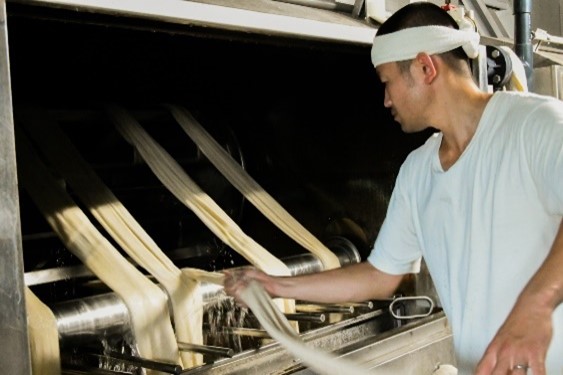
Contributions to and effects on biodiversity conservation
We have improved the wastewater problem at towel manufacturing factories using our proprietary towel manufacturing patented technology, "Self-Cleaning Method".
It enables coexistence with the local ecosystem and builds a water resource recycling system for agriculture and aquaculture. Achieving nature positivity in towel manufacturing
In addition, by using less energy than conventional technology that required high energy, we were able to switch the energy source from heavy oil to local natural resources (firewood from thinned wood), which enabled us to manage and utilize local natural resources.
We were able to construct a circulation system that can achieve both these goals, which has led to improvements in various issues.
Examples of efforts by private sector
Izumisano City, Osaka Prefecture, where our company's head office is located, is the birthplace of towel manufacturing in Japan, and has been a thriving area for towel manufacturing since 1891. In a national river water quality survey conducted by the Ministry of the Environment in 1998, the Kashii River, which flows through the area, was ranked the worst river in Japan. By improving the wastewater problem from towel manufacturing factories that caused such river pollution, we are contributing to halting the further decline in local biodiversity.
Chubu Recycle Co.,Ltd. / Reduction melting technology, reductive-molten stone (CR stone), molten metals, etc.
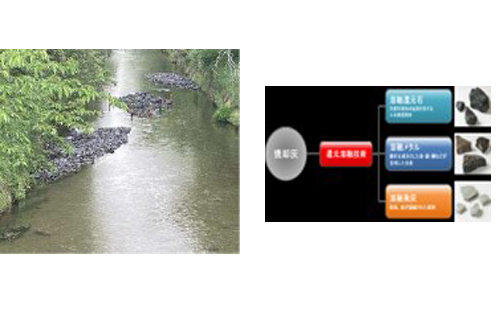
Contributions to and effects on biodiversity conservation
・Through the recycling of metals, including rare metals, the amount of metal recovered will be approximately 60 kg for Au, approximately 1,000 kg for Ag, and approximately 200 tons for Cu (as of 2022).We reduce environmental pollution and the impact of pollution on ecosystems due to mining, and thereby contribute to the conservation and revitalization of biodiversity.
・Actively use reductive-molten stone (resourced amount of reductive-molten stone: approximately 16,000 tons/year (as of 2022)) primarily as a civil engineering construction material for river construction, port construction, and other waterside environment improvement projects.By doing so, we contribute to the conservation and revitalization of the habitat of diverse organisms near water.
・Extend the lifespan of incinerated ash landfill sites (the amount of incinerated ash recycled is approximately 30,000 tons/year (as of 2022)) and suppress the development of landfill sites, contributing to the conservation of green spaces and biodiversity.
Examples of efforts by private sector
We recycle 100% of the waste collected by local governments and incinerated ash generated from the incineration of private industrial waste in Japan by using our reduction melting technology. (see Figure 1 Recycling process)
Through recycled products (“Reductive-molten stone”,“molten metals”, “molten fly ash”), we reduce environmental pollution caused by mining of metal-containing ores and natural stones and keep on contributing to the conservation and revitalization of forests and the creatures that grow there.
In addition, because of waterside environment maintenance work using reductive-molten stone, it contributes to creating a positive habitat for a variety of organisms and the number of individual species (see Figure 2 Construction example of using reductive-molten stone).
NEC Corporation / Smart farming management “CropScope”
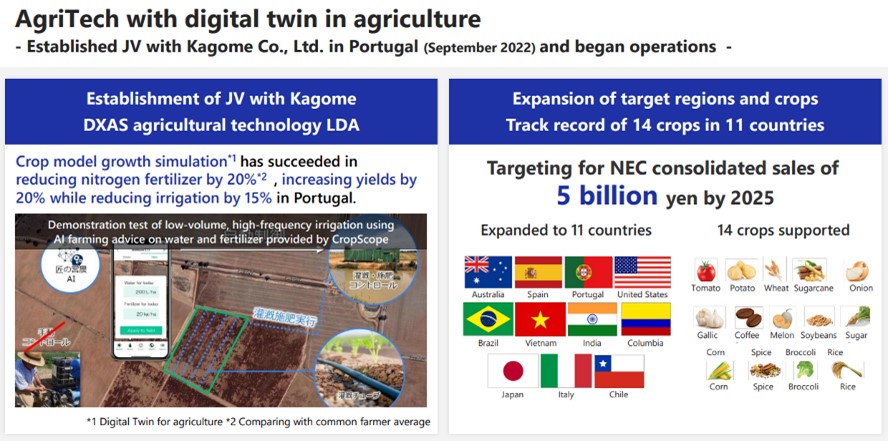
Contributions to and effects on biodiversity conservation
Kagome Co., Ltd and NEC conducted demonstration tests in Portugal, using AI farming advice on irrigation and fertilization provided by CropScope, in order to realize the automation of pulse drip irrigation. As a result, they succeeded in increasing the yield by about 20%, with about 15% less irrigation when compared to a field that did not utilize CropScope.
Examples of efforts by private sector
CropScope innovates agricultural operations with digital agriculture utilizing AI and data analytics. Optimize the entire value chain players in food and agriculture.
Itoki Corporation

Contributions to and effects on biodiversity conservation
By promoting the use of domestically produced wood, the Company restrains the deterioration of domestic forests and encourages appropriate, periodic forest management, thereby contributing to the improvement of ecology services.
Examples of efforts by private sector
Itoki is implementing the Econifa project to integrate domestically produced wood into offices and urban spaces by using the wood to create stylish furniture and interior products.
Using conifers, which are the dominant type of trees in Japan, in products of sophisticated design and applying the design template, Itoki aims to realize a high-level recycling society by means of contributing to an increase in forests' carbon absorption capacity through appropriate forest maintenance and an increase in CO2 sequestration due to the use of wood in urban areas.
Tokio Marine & Nichido Fire Insurance Co., Ltd.
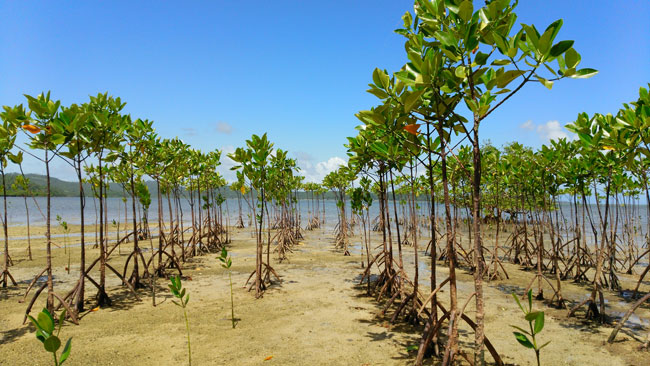
Contributions to and effects on biodiversity conservation
Through mangrove forest conservation, the Company mitigates the threat from climate change and disaster damage, protects the rich diversity of sea and land areas and makes people's lives and society safe, secure and sustainable.
Examples of efforts by private sector
Since 1999, under the concept of "Insurance for the Future of the Earth," Tokio Marine and Nichido has provided mangrove-based solutions on a global scale in cooperation with stakeholders, including planting NGOs, local communities, employees, insurance agents and customers. The Company published the Mangrove Planting 100-Year Declaration in 2007 and Mangrove-Based Value Co-Creation 100-Year Declaration in 2019 and participated in the United Nations Community of Ocean Actions for supporting implementation of SDG 14. In addition to planting activities abroad, the Company is engaging in various environment conservation activities in Japan and is implementing the mangrove-themed education program "Green Lessons" for raising environmental awarness. The cumulative total economic value created between April 1999, when it started planting, and the end of March 2019, came to 118.5 billion yen. The cumulative total value to be created in the period through 2038 is estimated to increase to 391.2 billion yen.
SUMITOMO CHEMICAL COMPANY, LIMITED / Atmospheric CO2 reduction and soil fertilization by mycorrhizal fungi.
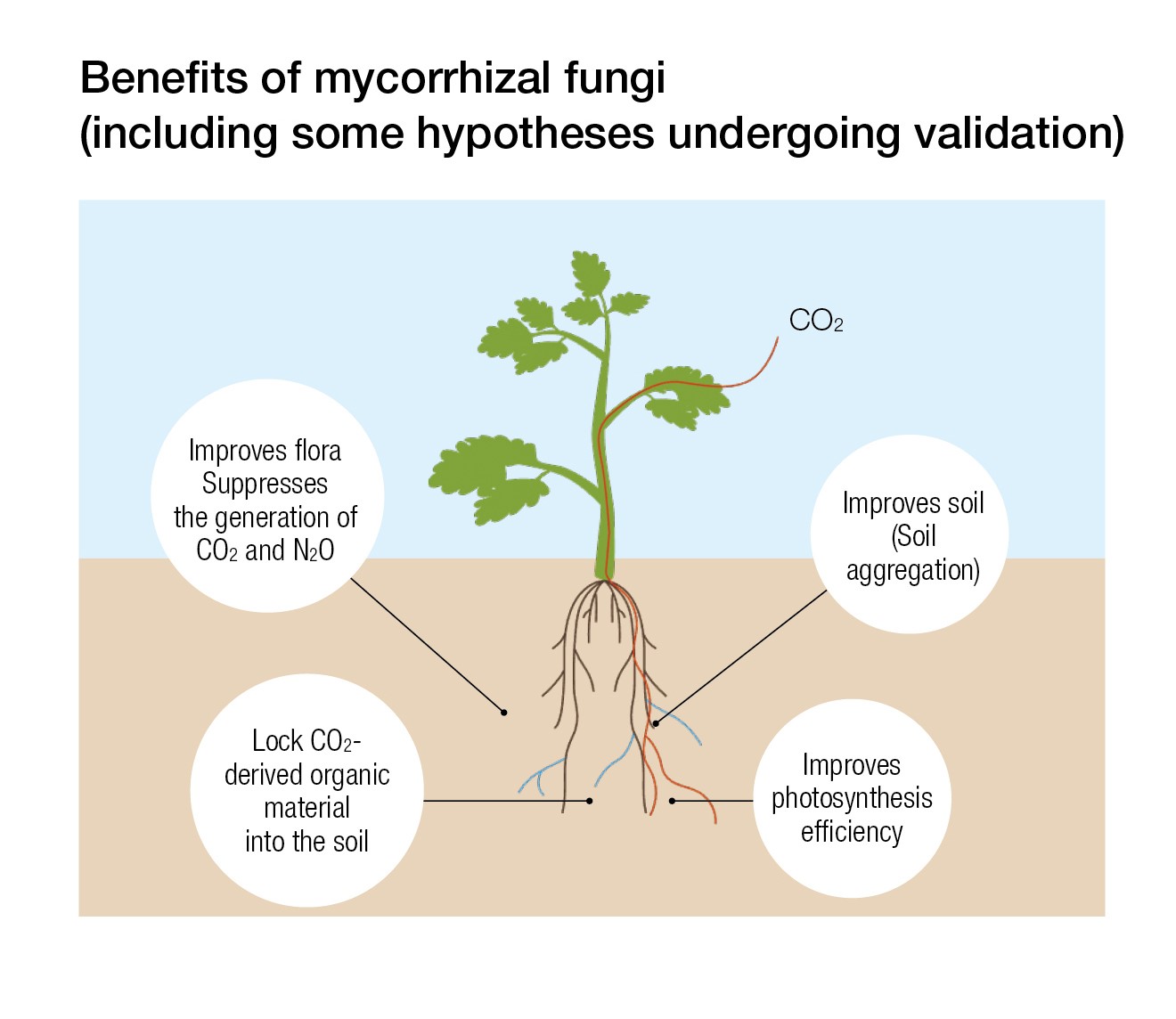
Contributions to and effects on biodiversity conservation
・Promotes CO2 absorption by plants through photosynthesis
・Locks CO2-derived organic material into the soil
・Suppression of CO2 and N2O generation by improving bacterial flora
・Soil improvement and avoidance of soil erosion through aggregation
Examples of efforts by private sector
Mycorrhizal fungi, a type of soil-dwelling microorganism that lives in symbiosis with plant roots, stimulates plant growth by accepting carbon compounds produced by plants through photosynthesis. This property increases the amount of carbon compounds in the soil and promotes carbon fixation, thereby reducing atmospheric CO2 and contributing to soil fertility. Sumitomo Chemical is working on the development of technology utilizing mycorrhizal fungi to achieve carbon neutrality and solve food problems.
iGrid Solutions Co., Ltd. / GX Solution model; Utilizing GreenTech to circulate rooftop sunlight without harming nature.

Contributions to and effects on biodiversity conservation
We continue to install solar power generation facilities on the roofs of existing facilities, and currently have over 600 facilities, making us one of the largest solar power generation facilities in Japan that do not use the FIT system. In addition to contributing to a decarbonized society through the spread of renewable energy, we are also expanding environmentally friendly solar power generation facilities which is associated with the promotion of renewable energy that do not impose any burden on the natural environment such as deforestation and land reclamation and are maintaining the ecosystem of animals and plants that live in forests.
Examples of efforts by private sector
◆One of the largest Solar power generation facilities utilizing the roofs of existing buildings in Japan*.
One of our subsidiaries, VPP Japan, started creating solar power generation facilities utilizing the roofs of existing buildings such as supermarkets and logistics warehouses in 2017.Currently, there are 672 facilities with an output scale of 146 kWinstalled, making us one of the largest in Japan.
(* Solar power plants that do not use the FIT system)
◆Utilizing our proprietary forecasting technology model,“R.E.A.L. New Energy Platform”to build a next-generation energy platform.
→R.E.A.L.New Energy Platform (energy management system)
We have built an energy management system that enables integrated information management and control of various data including demand forecasts, power generation forecasts, area characteristics, weather characteristics, and electricity usage characteristics of industries and facilities. This solves the difficulty of controling generated electricity storage and also the fractuation of generated electricity amount due to weather conditions.R.E.A.L. New Energy Platform.
→Disaster prevention measures through energy management -The system stabilizes the power system and functions as a backup power source in the event of a disaster,contributing to strengthening the resilience of the community.
→The system can be installed on rooftops in maximum quantities by taking advantage of forecasting technology.This allows iGrid Solutions ,an electricity retailer,to purchase electricity that is not fully used within the facility and supply it to subscribers. This enables the use of renewable energy without surplus power.
Kagome Co., Ltd.
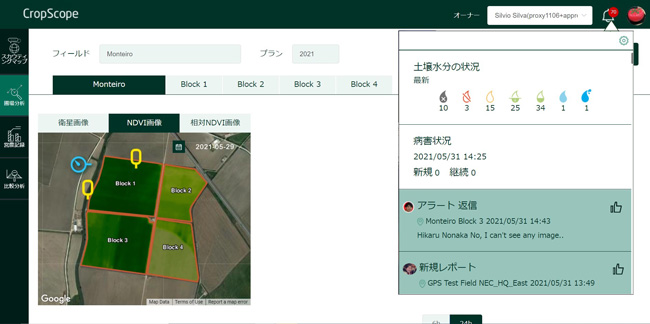
Contributions to and effects on biodiversity conservation
The Company can mitigate the negative impact of agricultural production on biodiversity as a result of developing tomato growing technology and reducing the use of water, chemical fertilizers and agrochemicals.
Examples of efforts by private sector
The Company, jointly with NEC Corporation, has developed the most advanced precision farming technology for tomato cultivation. The use of weather and soil sensors installed in tomato fields and satellite data enables for the visualization such as tomato crop growth and field conditions.
In addition, the use of AI which learned master grower’s farming policy combined with model-based crop simulation provides optimized irrigation and fertilization amount and timing. As a result, regardless of the level of growers’ skills, it can realize the tomato production stabilization as long as cultivation cost optimization.
Moreover, the Company guides the way to minimize the use of agrochemicals by indicating the appropriate timing of agrochemicals spraying based on a disease pressure forecasting model. The cutting-edge tomato-growing technology can realize an environment-friendly, sustainable agriculture.
Lawson, Inc.
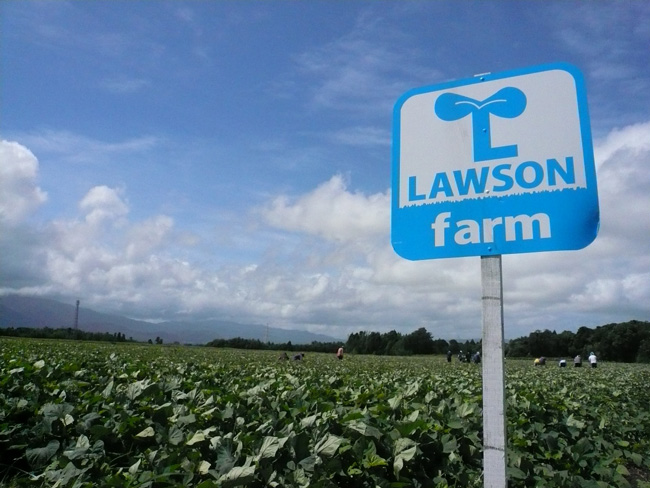
Contributions to and effects on biodiversity conservation
"Lawson farms" can mitigate the negative impact of agricultural production on biodiversity by reducing the use of agrochemicals and fertilizers. In addition, Lawson farms contribute to the dissemination of biodiversity-conscious agriculture by promoting the acquisition of JGAP certification.
Examples of efforts by private sector
In order to supply vegetables and fruits to the Lawson group in a stable manner, the Company operates "Lawson farms," which have the status of a legal person eligible to own farmlands, at 17 locations across Japan. Lawson farms conducts ideal fertilization based on examination of the balance of nutrients through detailed soil analysis. They also engage in the Nakasima-style farming, which constantly keeps track of the crop growth situation and conducts appropriate growth control.
In addition, Lawson farms strive to acquire GAP certification and to secure the sustainability of quality improvement, food safety and environment conservation.
NTT DATA Group Corporation / “iQuattro®” promotes the realization of inter-company digital supply chains with full process support
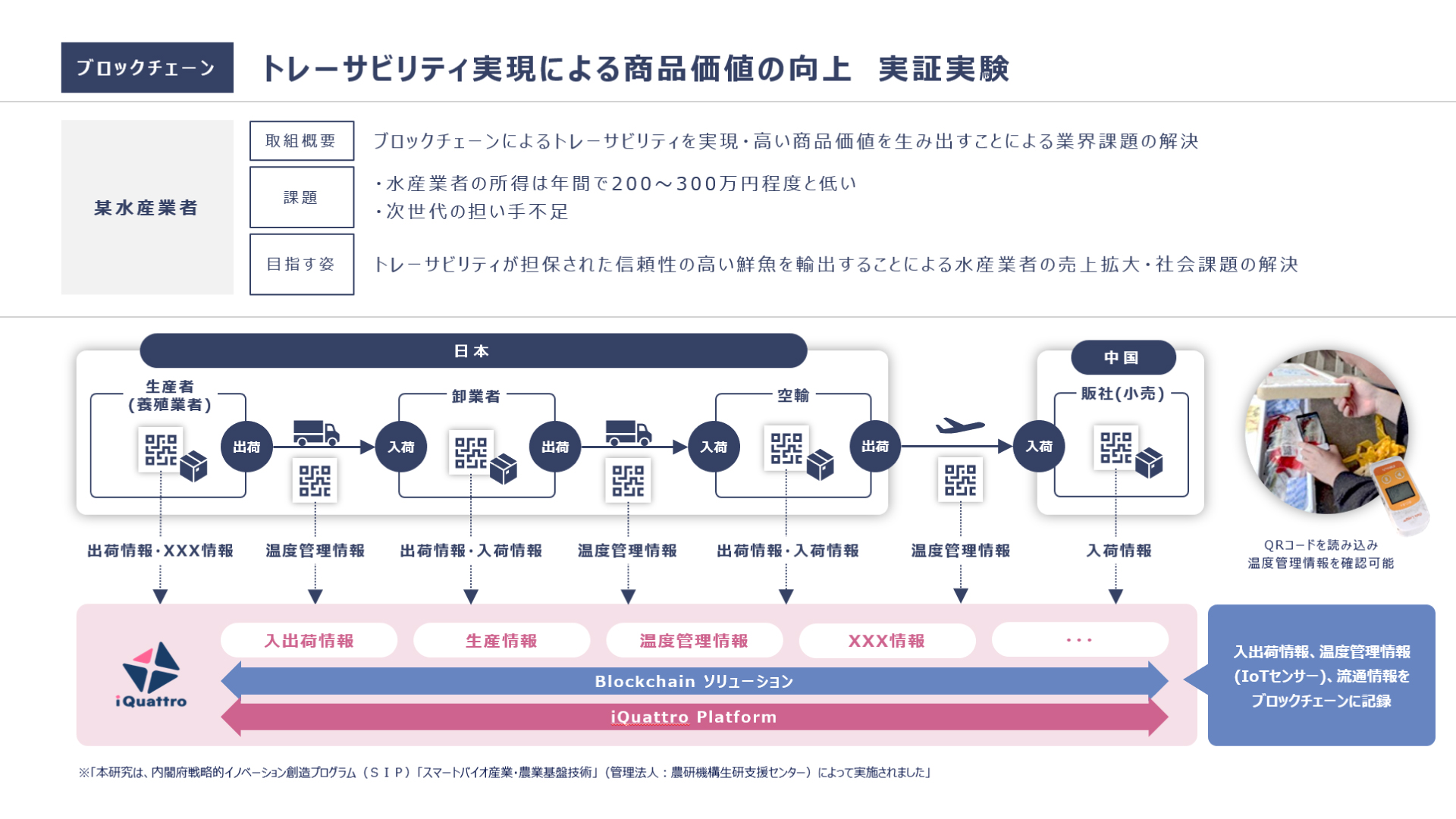
Contributions to and effects on biodiversity conservation
・Prevent the distribution of IUU fishing (Illegal, Unreported, Unregulated) and conserve marine resources and biodiversity
Examples of efforts by private sector
iQuattro® is a solution for connecting and utilizing data between companies from upstream to downstream in the supply chain. By using blockchain technology, it is possible to consistently add information to this data by the companies involved, and it is also possible to eliminate the risk of falsification and increase reliability. You can register producer and distributor information in iQuattro® and manage product information consistently. In addition, information management among stakeholders in the supply chain will become more efficient, leading to more efficient communication with upstream and downstream business partners and solving issues such as system separation between each business. In addition to the accelerating movement to require companies to disclose nature-related information, there is also a growing trend in the EU to ensure that certain agricultural products (soybeans, beef, coffee, cocoa, etc.) are not involved in deforestation. Efforts to understand the upstream supply chain impacts of specific fields and items are expanding, with a law (Forest Prevention and Destruction Act) requiring proof of this at the time of sale within the region being agreed upon in December 2022.
NTT DATA Group Corporation / Aisaku®, a farming support platform that supports smart agriculture.
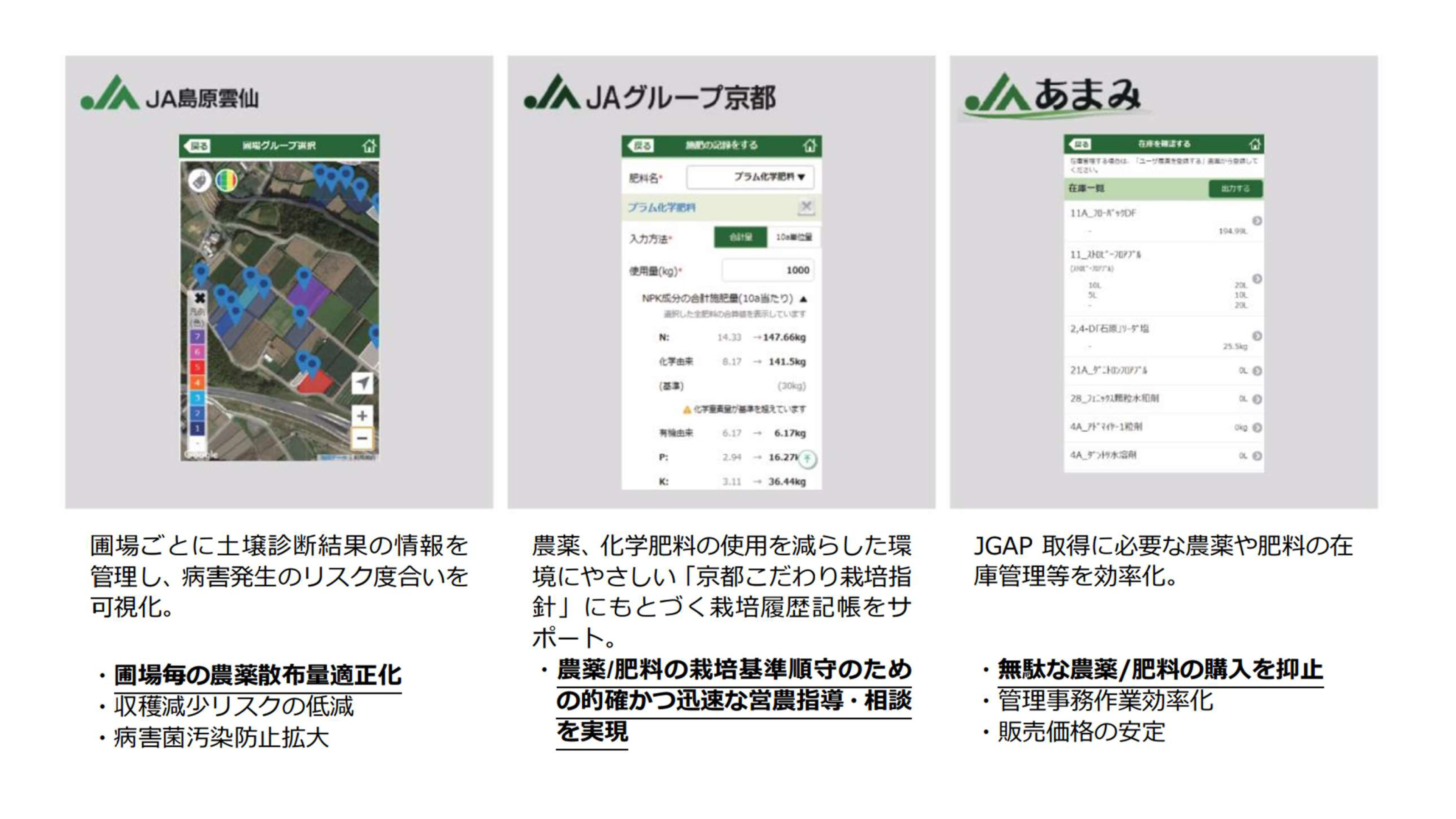
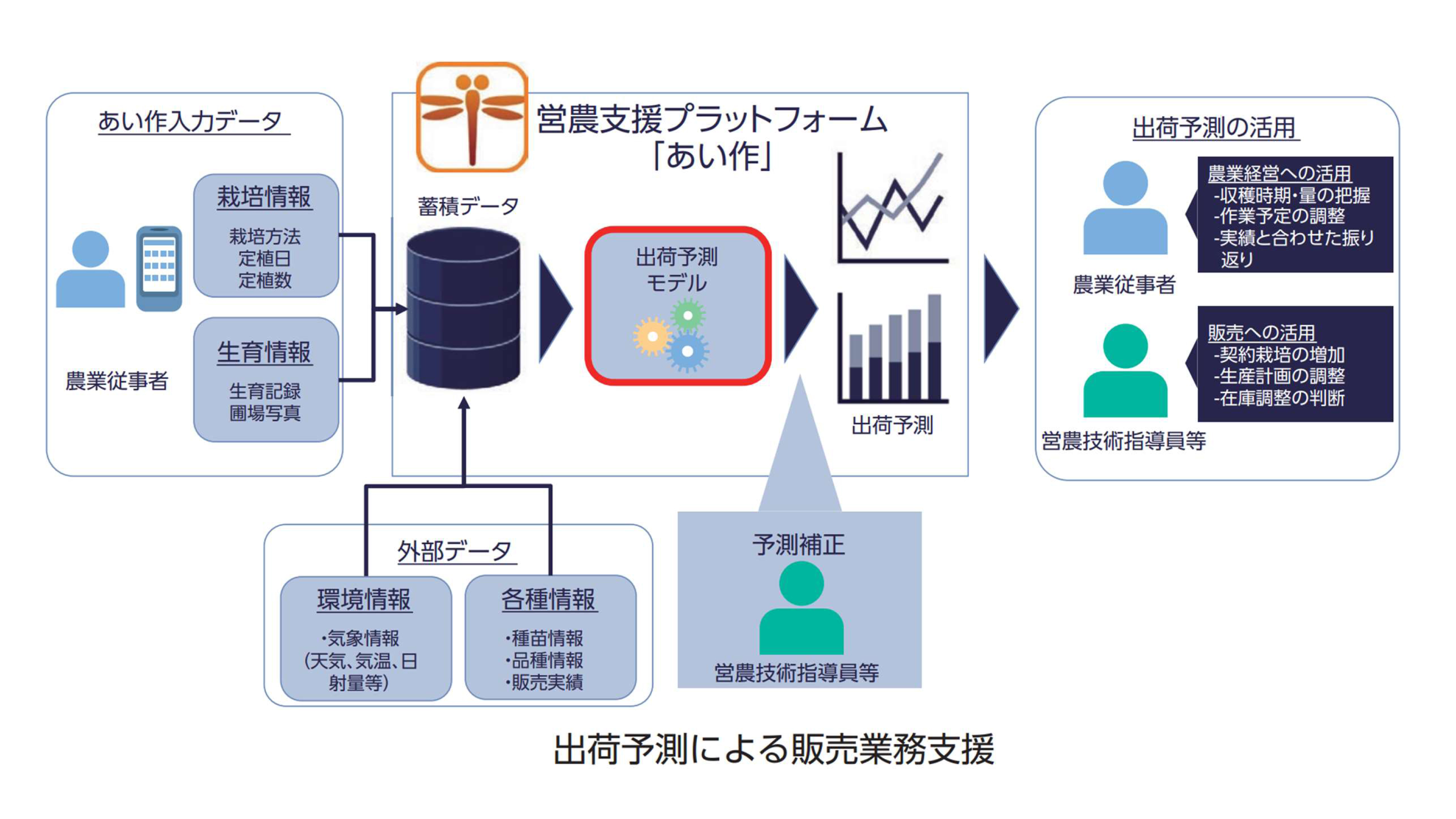
Contributions to and effects on biodiversity conservation
・Reducing the burden on biodiversity through proper management of pesticides and fertilizers (avoiding overdosing)
Examples of efforts by private sector
Aisaku® provides a function for farmers to input cultivation information into smartphones or tablets and for the staff of agricultural cooperatives, etc., to grasp the cultivation information input by producers. This not only visualizes cultivation information in the production area, but also promotes communication between the two parties, thereby improving the quality and efficiency of farming activities. In addition, the system manages data on soil characteristics, agricultural chemicals, and fertilizers for each farmland, and generates shipment forecast data using a forecast algorithm unique to the production area based on cultivation, growth, weather, and other information as inputs. It also supports environmentally friendly and green farming practices, such as reducing crop loss and waste of pesticides and fertilizers by harvesting crops at the right time. Aisaku® has also been certified as a recommended farm management system by the Japan GAP Association, and can be used to practice GAP* and obtain certification.
JA Kagawa and JA Shimabara Unzen have publicized examples of use of GAP, such as "efforts to manage the amount of fertilizers and agricultural chemicals, reduce the amount of submitted materials, and reduce waste loss by leveling shipping strategies using a broccoli shipping forecast model" by Kyoto Prefecture, JA Kyoto Central Association, and JA Kyoto Ninokuni. JA Kagawa and JA Shimabara Unzen have announced "initiatives to manage the amount of fertilizers and pesticides, reduce the amount of materials submitted, and reduce waste loss by leveling shipping strategies using a broccoli shipment forecast model.
*GAP=Good Agricultural Practice (Good Agricultural Practice), an initiative to ensure food safety, environmental conservation, labor safety, and other aspects of sustainability in agriculture.
ALEPH INC. / Procurement of sustainable rice bearing biodiversity in mind
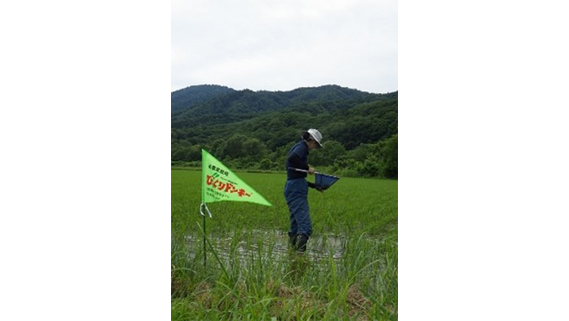
Contributions to and effects on biodiversity conservation
・Consumption of rice at restaurants helps the conservation of more than 1,000 hectares of biodiversity-friendly rice paddies nationwide.
Examples of efforts by private sector
To serve safe and quality rice stably, it has concluded contracts with over 400 farmers to produce Shou-nou-yaku-mai, less agrochemical rice, with only a single application of herbicide based on ALEPH’s strict specifications in over 1,000 hectares of rice paddies.
Living things monitoring is included in the specification, farmers increase their interest in organisms in the rice fields and it encourages them to take methods to improve biodiversity, such as postponing mid-drying.
Furthermore, a total of 1,000 customers of restaurants have participated in the“Bikkuri Donkey’s Living thing monitoring” at contracted farms’ rice paddies.
[Less agrochemical rice’ criteria]
(1)Application of herbicide is allowed only once, and it's prohibited to use insecticides and fungicides including ridgeway
(2)Limit chemical fertilizers to less than half of the conventional amount
(3)Recommend application of organic fertilizer
(4)Require contract producers to monitor living things in rice paddies annually
(5)Encourage taking actions and reporting considering the biodiversity in their rice paddies
Nippon Yusen Kabushiki Kaisha / Visualization of biodiversity in the open ocean by collecting environmental DNA using ships

Contributions to and effects on biodiversity conservation
・Using ships, it becomes possible to understand the biota and ecosystems of the open ocean, which are particularly unknown
・By understanding the “state” and “changes” of open ocean biota and ecosystems, it becomes possible to plan and implement effective measures for biodiversity conservation
・By understanding the “state” and “changes” of biota and ecosystems in the open ocean, it becomes possible to create indicators for biodiversity conservation in the open ocean
Examples of efforts by private sector
・Collecting environmental DNA through seawater sampling on the liner "Mashiu", which sails between Hitachinaka Port (Ibaraki Prefecture) and Tomakomai Port (Hokkaido), utilizing the business route of group company "Kinkai Yusen Co., Ltd." Currently being implemented.
・Sampled seawater and environmental DNA will be transported to Hokkaido University and analyzed. Analysis results will be published on “ANEMONE DB”
Oji Holdings Corporation / Sustainable forest management that reconciles timber production with biodiversity conservation.Contributing to the marine ecosystem through forest management.
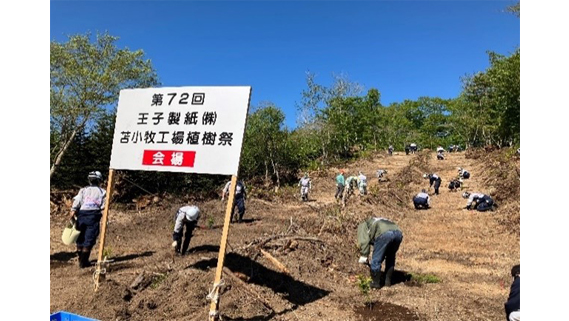
Contributions to and effects on biodiversity conservation
・Conservation of marine ecosystems through material circulation in mountains, rivers, and oceans
・Education of the public regarding the connectivity of the above ecosystems
Examples of efforts by private sector
Healthy forests contribute to marine ecosystem that supports fishery resources by supplying nutrients such as nitrogen and phosphorus to the ocean through rivers. Conversely, poorly maintained forests are known to have a negative impact on marine ecosystem through oversupply of fallen trees and sediment.
Tomakomai Factory, one of Oji’s main factories, has been holding a tree-planting festival for over 70 years, and since 1995, based on the idea that “forest grows fish,” the Tomakomai Fisheries Cooperative Association has also joined the event. They participate as part of “tree-planting campaign to increase fish production”. In this year, the event was held in late May, with a total of 70 people planting 600 trees. This campaign has contributed to increase of wood resources and securing Tomakomai City's abundant marine resources, such as surf clams (ranked No. 1 for catches among the cities in Japan for 22 consecutive years).
The Norinchukin Bank / Forest regeneration efforts by Nochu Potential Forest Productivity Fund, a charitable trust.
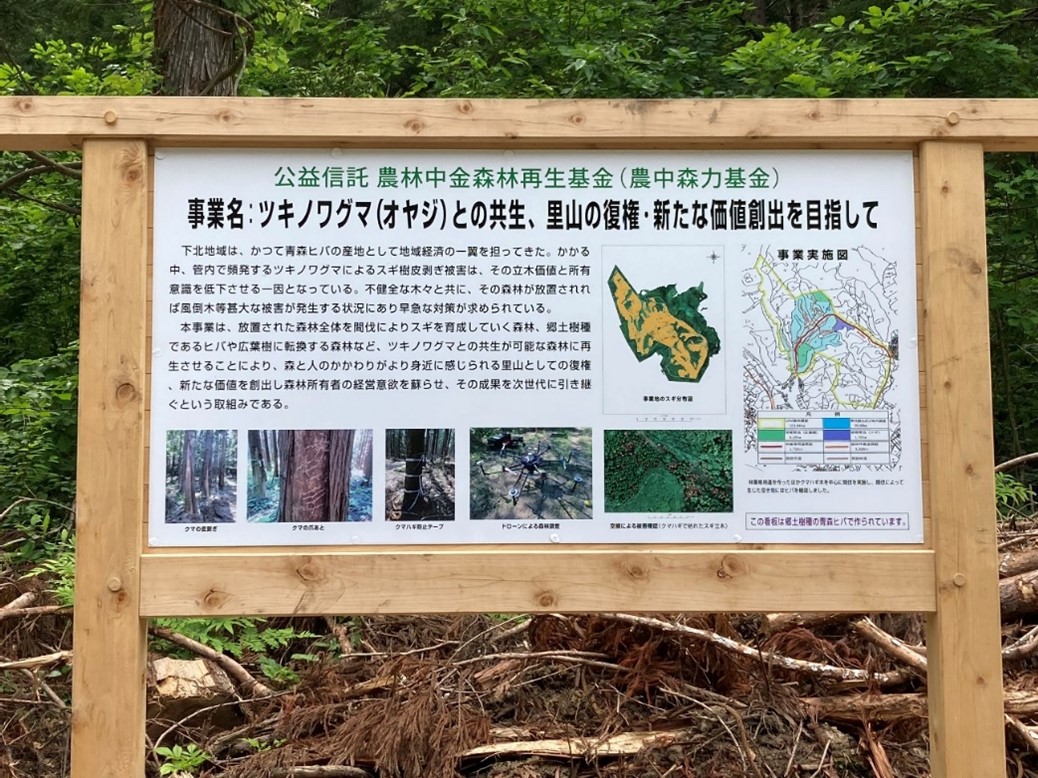
Contributions to and effects on biodiversity conservation
This charitable trust contributes to the preservation of forest biodiversity by subsidizing efforts to restore forests with apparent disease and insect damage to a rich diversity for recycling and utilization (Hanamaki City Forest Cooperative), and efforts to coexist with black bears by reducing bark stripping by asian black bears and partially replacing some species with HIBA and broad-leaved trees, which are native species to Aomori Prefecture (Shimokita Regional Forest Cooperative), among others.
Examples of efforts by private sector
A charitable trust was established to subsidize projects that aim to bring out the public benefits of forests by regenerating forests (privately owned forests) that have been degraded due to lack of maintenance. Through grants from charitable trusts, we are promoting efforts to sustainably demonstrate the multifaceted functions of forests, including biodiversity. Including ongoing projects, we have carried out 123 forest regeneration projects over the past 18 years.
To improve the public benefits of forests and contribute to the healthy circulation of forest resources, we carry out not only thinning artificial forests through road network maintenance in degraded privately owned forests, but also developing broad-leaved trees by creating mixed forests.
TOYOTA MOTOR CORPORATION
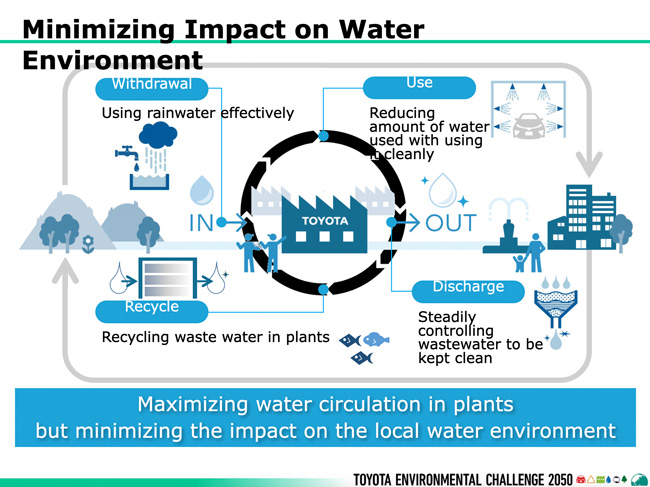
Contributions to and effects on biodiversity conservation
The Company contributes to the creation of favorable water environments and the conservation of river and ocean ecosystems.
Examples of efforts by private sector
Toyota has been, in each plant, minimizing impact on water environment through 'thoroughly reducing the amount of water usage' and 'purifying wastewater thoroughly and return'. For example, it has been promoting various initiatives such as collecting rainwater to reduce industrial water usage, cutting water usage in production processes, recycling wastewater to reduce amounts withdrawn from water sources and returning high-quality water to local environments.
NGK Insulators Ltd.

Contributions to and effects on biodiversity conservation
The Company contributes to biodiversity conservation and the reduction of the environmental burden from the viewpoint of preventing air pollution.
Examples of efforts by private sector
The Company has developed and sells the Honeyceram® substrate for automobile catalytic converters, which purifies harmful substances contained in automotive exhaust gas and the NOx sensor which is the world's first on-vehicle sensor that can measure the density of nitrogen oxides (NOx) in exhaust gas with high precision in real time. The cumulative shipment volume of Honeyceram substrates amounts to more than 1.5 billion units, a sufficient volume to reduce NOx emissions by 4 million tons per year (equivalent to double the volume of annual NOx emissions in Japan).
SHIMIZU CORPORATION/ Yatsubori Shimizu Yatsu
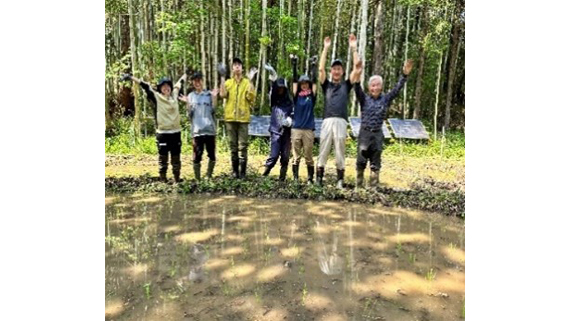
Contributions to and effects on biodiversity conservation
・Cases of utilizing natural regulatory functions for biodiversity
・Cases where corporate enterprise can participate in regenerating biodiversity when there is a shortage of funds or human resources
・Contribution to OECM
Examples of efforts by private sector
The decline of Yatsu, small valleys with natural springs, close to people's living areas not only deprives wetland flora and fauna of growth and habitat but also takes away opportunities to utilize the valley environment from future generations. This is a case in which a corporate enterprise , research institutes, residents, and local governments collaborated to restore a fallow rice field as a wetland-green infrastructure. The team contributes to resource recycling efforts that convert felled woods into biochar to J-credits and provides a window for people to interact with nature through events.
Obayashi Corporation
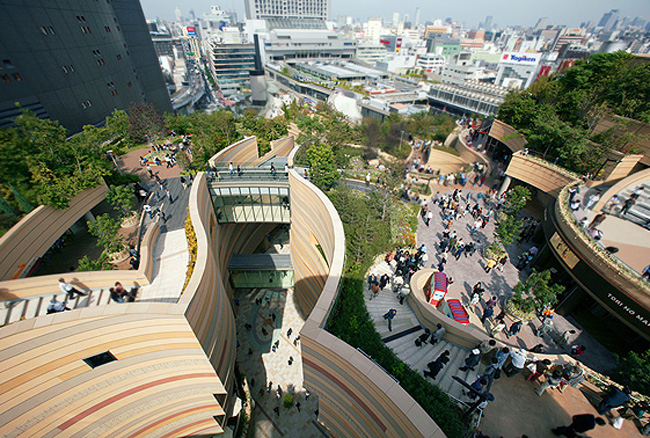
Contributions to and effects on biodiversity conservation
The Company is creating urban spaces in which people and wildlife cohabit. A rich environment hosting 34 species of birds and 152 species of insects, including Brown Flycatcher (Endangered Species II as designated by Osaka Prefecture), Eastern Crowned Leaf Warbler (Semi-Endangered Species as designated by Osaka Prefecture), Conocephalus chinensis, and Orthetrum triangulare melania, has been developed there.
Examples of efforts by private sector
The Company is growing 500 species of trees and flowers totaling 100,000 stocks on half of the around 11,500 square meters of the roof-top garden space of the Namba Parks redevelopment complex. It strives to realize cohabitation with the natural environment in urban areas and to reduce the burden on the environment. At the same time, it continuously monitors the improvement effects of those measures. A dedicated staff has operated and managed the rooftop green area for more than 10 years. In this way, the Company has created urban spaces in which people and wildlife cohabit.
SEKISUI HOUSE
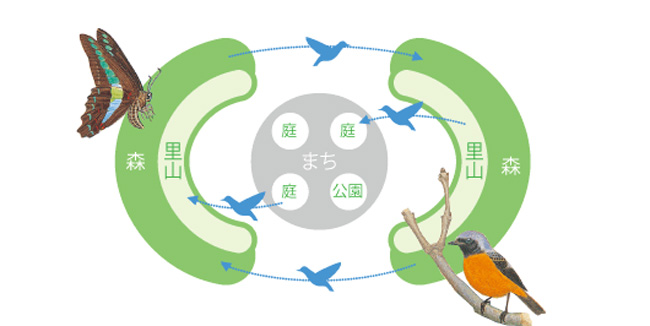
Contributions to and effects on biodiversity conservation
The Company created habitats for wildlife and corridors for movement by planting a cumulative total of 17.09 million trees in customers' gardens by the end of January 2021 as a result of planting more than 1 million trees annually, thereby contributing to the formation of ecosystem networks in urban areas.
Examples of efforts by private sector
Between 2001, when the Five Tree Plan started, and FY2020, the Company planted a cumulative total of 17.09 million trees, mainly native species, under the plan. Under the "Gohon no ki" Plan, in order to implement the greening of detached houses and condominiums, the Company engages in ecosystem-conscious garden and town development by mainly planting native plants, after obtaining customers' understanding. The Company also created a system to enable online access to tips on how to appreciate and maintain planted trees and information on butterflies and birds that may be attracted by the green.
Dai-ichi Life Holdings, Inc.
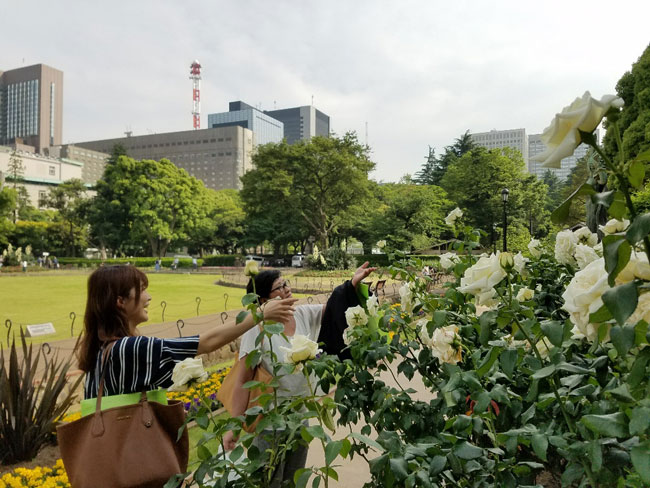
Contributions to and effects on biodiversity conservation
The Company contributes to improving urban-area residents' access to green by supporting urban greening activity.
Examples of efforts by private sector
Since 1990, when it established the Green Environmental Plans Award, Dai-ichi Life Insurance has supported greening activity in order to contribute to urban greening. Currently, the Company is a special supporter of three environmental awards, including the Green Environmental Plans Award, the Green Cities Award, and the Competition for Specialized Greening Technology for Rooftops and Wall Facings. The number of green areas for which the Company provided support increased to more than 330 by 2020. As a result, the Company has contributed not only to the development of communities where people and nature can cohabit but also to environment conservation, including climate change mitigation measures, mainly planting, and biodiversity conservation.
Futago Tamagawa Rise Council
Total Administrator
Tokyu Corporation
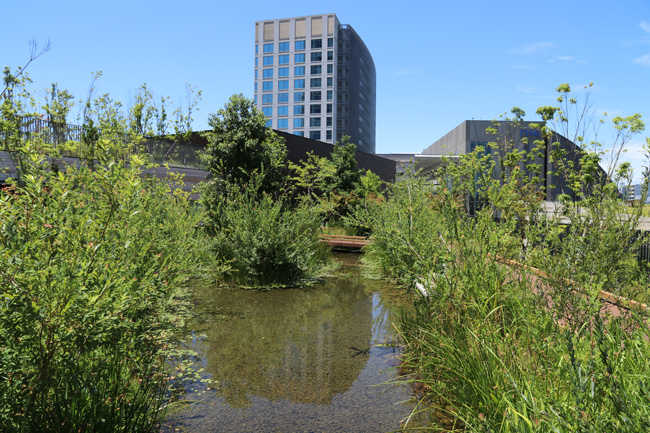
©Futakotamagawa Rise
Contributions to and effects on biodiversity conservation
The Company connected neighboring ecosystems along the Tama River under a plan for the planting of seedlings of native species of plants, including the Aster kantoensis, which is the endangered plant and inhabits the Tama River area. The Futago Tamagawa Rise complex provides opportunities for learning about the local natural environment and ecosystems.
Examples of efforts by private sector
The Futago Tamagawa Rise complex, which comprises commercial facilities, offices, a cinema complex, a hotel and condominiums, is intended to create spaces for cohabitation with the local nature based on the “eco-museum“ concept, which seeks to create a natural environment by connecting local ecosystems. The complex contributes to the creation of a network that connects the ecosystems of the Kokubunji cliff line and the Tama River area. The Company takes special care to adopt native species of plants in order to reproduce the original local natural environment.
Mitsui Fudosan Co., Ltd.
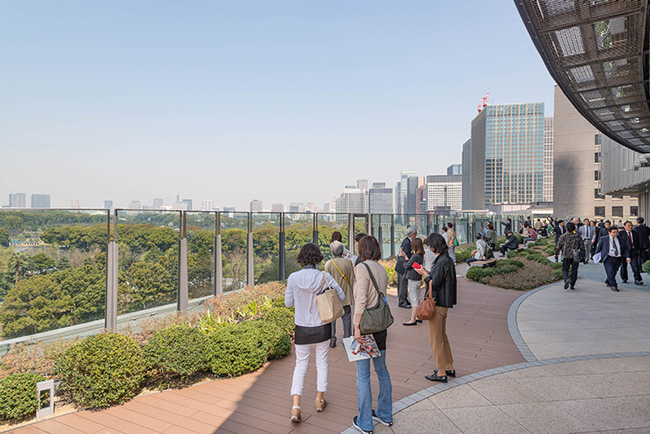
Contributions to and effects on biodiversity conservation
The Company contributes to urban biodiversity conservation by creating urban spaces in which people and wildlife can cohabit.
Examples of efforts by private sector
At Tokyo Midtown Hibiya (Chiyoda Ward, Tokyo), the Company made active efforts to introduce the same species of trees as those planted in the adjacent Hibiya Park, mainly native species, out of consideration for harmony with the park's lush green. In addition, the Company created green areas totaling around 2,000 square meters (greening rate of 40%) by installing the Park View Garden (sixth floor) and the Sky Garden (ninth floor).
TAISEI CORPORATION
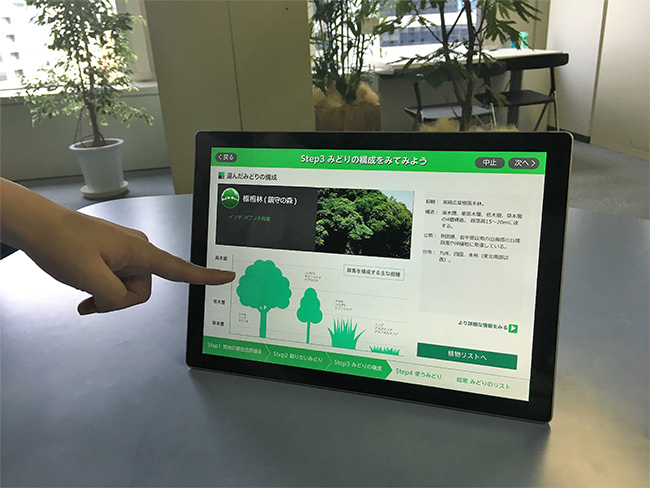
Contributions to and effects on biodiversity conservation
The Company contributes to creating diverse green structures, including grasslands and forests, and securing diversity by proposing plant varieties that take account of the process of local vegetation succession. It also raises interest in biodiversity and creates a favorable environment by making clear the impact of the creation of diverse green structures on the biota based on predictive assessment. In addition, the Company contributes to the conservation of as many species as possible by facilitating the formulation of conservation plans for rare waterfront animals and plants.
Examples of efforts by private sector
The Company developed the "Ikimono Concierge" predictive assessment tool to identify animals that may be introduced in light of the locations of the planned conservation areas and requests (e.g., requests to create a forest, a grassland or a waterfront), the "Mori Concierge" plant variety selection tool to propose plants best suited to the planned areas in light of the local characteristics, and the Mizube Concierge tool for formulating conservation and for rare waterfront animals and plants.
Sekisui House, Ltd./ The Gohon no ki(“five trees”) Project

Contributions to and effects on biodiversity conservation
Sekisui House has since 2019 been working with the Kubota Laboratory, Faculty of Science, University of the Ryukyus, and Think Nature Inc. to quantitatively evaluate the contribution of this network-type greening to urban biodiversity.Based on the Japan Biodiversity Mapping Project (J-BMP)³ managed and operated by Think Nature Inc., a company established by Professor Yasuhiro Kubota, the partners have analyzed the data on tree number, species, and location accumulated over the 20 years of the Sekisui House Gohon no ki Project to quantitatively evaluate the effectiveness of the project in conserving and restoring biodiversity.This quantitative evaluation revealed that the number of native tree species in each region per 1km mesh has increased 10 times from an average of 5 to 50 compared to the case without the Gohon no ki Project. It was found that they provide an environment where the number of bird species doubles from an average of nine to 18, and the number of butterfly species fivefold increases from an average of 1.3 to 6.9. It indicates that the increase in the number of native tree species lead to strengthen the foundation of biodiversity.This is the world’s first mechanism for quantitatively evaluating urban biodiversity and its application to an actual case. The disclosure of numerical data enables biodiversity to be expressed in terms of financial value, thereby providing a means for visualizing private sector contribution to biodiversity.
Examples of efforts by private sector
The Gohon no ki(“five trees”) Project based on the concept of“ Planiting five locally native trees, three for birds and two for butterflies.” It proposes greening gardens and local communities with native tree species suited to the local climate and benevolent to birds, butterflies, and other local fauna. As a standard for planting tree species, we have selected “The Gohon no ki” that are native to Japan and have evidence that are beneficial to birds and butterflies.Gardens, which are small “dots” become continuous “lines” within the city, and by connecting with local nature such as satoyama (which translates roughly as“village woodland”),they form an“ecosystem network” in urban areas and contribute to ecosystem conservation.This is not just a CSR activity but is creating new value as a landscaping and greening business that plays a part in the housing business. Thanks to the cooperation of many customers who support the idea of the Gohon no ki Project, a cumulative total of 19 million trees have been planted since the initiative began in 2001.On the north side of the Umeda Sky Building, where the Company is headquartered, we created the Shin-Satoyama Garden covering 8,000 m2, where 30 to 40 species of wild birds and more than 50 species of butterflies and insects can be observed every year, based on the principles of the Gohon no Ki Project. It is an urban green space and is a good example of biodiversity conservation efforts in urban areas.
SynecO,Inc./ Augmented Ecosystems/Synecoculture™
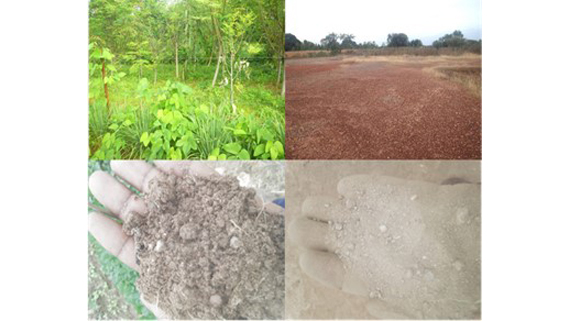
Contributions to and effects on biodiversity conservation
Augmented ecosystems, including Synecoculture, are a concept and method developed with the aim of creating a sustainable society in which human activities and natural capital are compatible. It goes beyond 'conservation' to restore and maintain ecosystems in their natural state, and encourages ‘augmentation' to achieve a high utility and functionality for both humans and nature. Synecoculture, which enables direct contributions to ecosystems and biodiversity in combination with economic activities (agricultural production), can, for example, resolve conflicts between local economic activities and natural capital in developing countries where most of biodiversity hotspots exist. At the same time, this augmented ecosystem concept can be deployed not only in food production, but also in green spaces, and other urban ecosystems where biodiversity is being lost.
*Synecoculture is a trademark of Sony Group Corporation.
Examples of efforts by private sector
The company is implementing and developing augmented ecosystems and Synecoculture™️* as a business. In augmented ecosystems, ecosystem functions are enhanced by increasing biodiversity beyond the natural state. Synecoculture is a method of open-field agriculture that —without the use of any plowing, fertilizers, agricultural chemicals, or anything else except for seeds and seedlings— allows for the creation and management of self-organizing ecosystems that bring out year-round harvest. In a case study conducted by Sony CSL, more than 150 species of useful plants were introduced on 500 m2 of land in Burkina Faso under local climatic conditions to achieve a high level of biodiversity. The experiment restored the local ecosystem (see picture). It was also confirmed that the enhanced ecosystem function contributed to the restoration of degraded land and consequently revitalised the local economy. In addition, case studies in Japan have shown that Synecoculture products were richer in micronutrients (especially minerals and bioactive metabolites produced by plants). SynecO, Inc. globally conducts consulting business on Synecoculture/augmented ecosystems by using data analysis, as well as business on improving literacy about ecosystem values and functions. Cases of Synecoculture practice by SynecO, Inc. include the introduction of Synecoculture plots on cocoa farms, the introduction of Synecoculture into the classrooms of private junior high school in Japan, and the introduction of Synecoculture into the premises of companies in urban areas and local governments in the context of Nature Positive.
MS&AD Insurance Group Holdings, Inc.
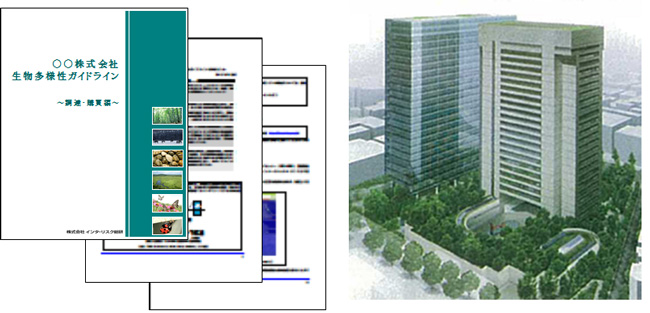
Contributions to and effects on biodiversity conservation
The analysis and evaluation of the impact of business activity on natural capital helps to minimize the ecological impact and damage.
Examples of efforts by private sector
Simplified evaluation service regarding water-related risks: Evaluate water-related risks (water depletion, contamination, floods, droughts, etc.) at domestic and foreign business locations in order to avoid the threat of depletion of water resources to business operations.
Environmental supply chain consulting: Analyze environmental business risks related to the procurement of raw materials on an industry-by-industry basis, prioritize the risks to address and support the development of supply chain management in order to establish sustainable procurement networks for raw materials.
Biodiversity-conscious land usage consulting: Provide a comprehensive set of support services, including investigation and analysis regarding utilization of properties hosting green areas, including business offices and condominiums, and the formulation of development and action plans based on the investigation and analysis.
Sumitomo Corporation / Forestry business in New Zealand
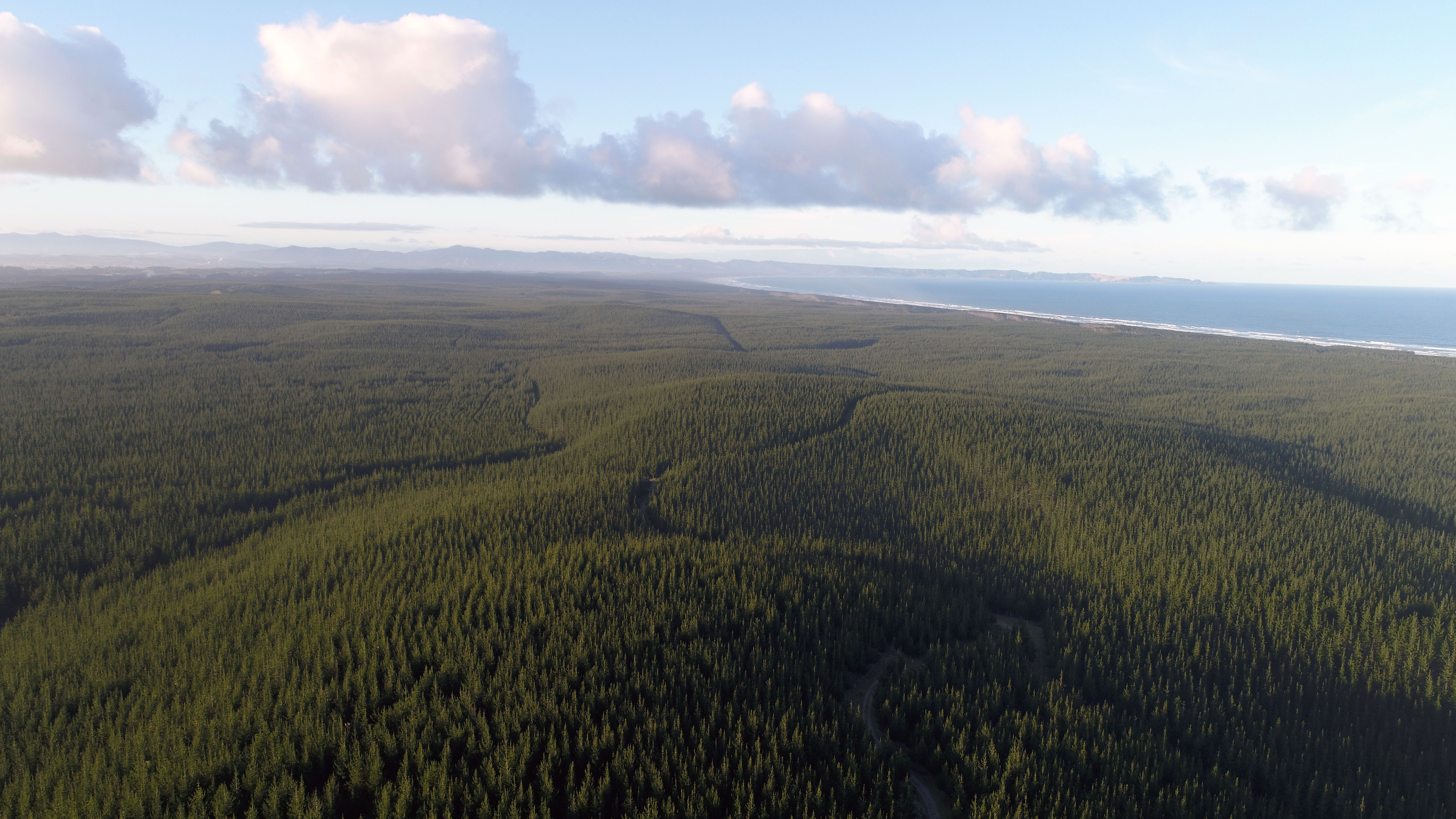
Contributions to and effects on biodiversity conservation
・Manage to maintain and restore the genetic biodiversity of native species through conducting ecological
surveys to monitor kiwi bird populations
・Conserve rare animals and plant species
・Implement bio-controls in cooperation with nature authorities
Examples of efforts by private sector
Summit Forests New Zealand own vast forest assets amounting to approximately 50,000 hectares in New Zealand. Within these Limited forests, we plant and grow radiata pine, a species of softwood, in a 30-year cycle. The harvested timber is sold domestically in New Zealand as housing material or construction supplies and also exported to China and South Korea. After logging, we reforest most of the land, except for some areas where reforestation is not contractually permitted, to protect and nurture the forest over a long period of time. We have accumulated expertise in forest management and developed a sustainable forestry business.
Mitsubishi Chemical Holdings Corporation
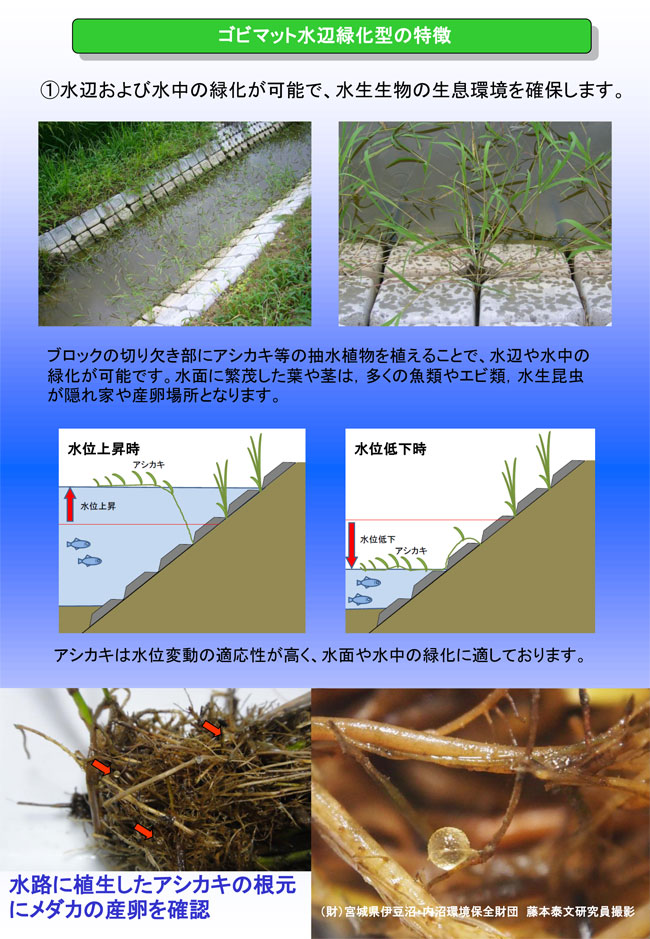
Contributions to and effects on biodiversity conservation
The Company selects products capable of responding to the loss of biodiversity and raising the biodiversity level. The Company widely demonstrates the appeal of products contributing to biodiversity and also contributes to biodiversity conservation through the expansion of sales of contributing products.
Examples of efforts by private sector
The Company selects products making significant contributions to biodiversity conservation from among products in its business fields, including functional productions and materials, and healthcare products, based on a comprehensive evaluation of factors such as direct contributions to biodiversity, life-cycle environmental footprint, and financial impact. Specifically, among the products selected are the following: a “decentralized water supply system installed with slow sand filtration equipment and drip irrigation equipment; the Gobimat, which is a blockmat for controlling soil erosion; the Tensar geogrids used as reinforcing elements in reinforced fill structures and slopes; a membrane separation bioreactor, which uses a hollow fiber membrane; and the BioPBS biodegradable plastics.
Mitsubishi Estate Company CO., LTD.
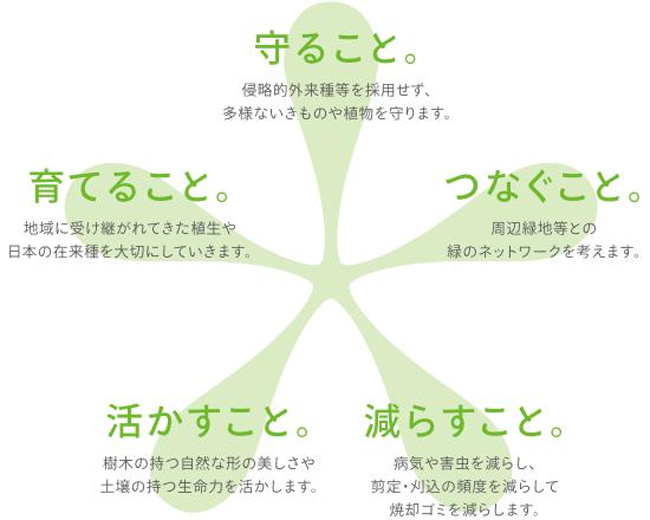
Contributions to and effects on biodiversity conservation
The Company contributes to the conservation of urban biodiversity by conserving and restoring the living environment for wildlife in urban areas in particular, by connecting individual green areas to create a "green network" and by conducting monitoring surveys of wildlife and disseminating information on the survey results.
Examples of efforts by private sector
The Company is implementing biodiversity-conscious planting plans on the premises of condominiums that it sells. By connecting individual condominium buildings with neighboring green areas and street greenery and creating greenspaces that function as transit points for plants and animals, the Company formulates extensive ecological networks.
Rakuten Group, Inc.

Contributions to and effects on biodiversity conservation
The Company contributes to the reduction of the negative impact of production activity and supply chains on biodiversity by introducing and selling foods, beverages, clothing, and daily products that have acquired certification (or have been manufactured in an environment-conscious manner).
Examples of efforts by private sector
At the EARTH MALL with Rakuten, a special site at Rakuten MarketIchiba, the Company introduces and sells certified products (FSC, MSC, ASC, RSPO, etc.) that have been manufactured under sustainable resource management for the purpose of creating a sustainable shopping culture (increasing the number of consumers who routinely purchase products manufactured with due consideration for the environment, society and economy during the processes of production, distribution, sales, usage, disposal and recycling).
Biome Inc. / Biodiversity information evaluation and disclosure support services group
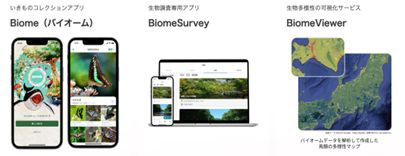
Contributions to and effects on biodiversity conservation
We will support the evaluation and disclosure of the relationship between business operators and biodiversity regardless of sector and promote a shift to business activities that take biodiversity into account.
Examples of efforts by private sector
Support for evaluation and disclosure of biodiversity-related information based on services such as biodiversity index maps, biological survey DX tools, citizen participation biological information collection apps, etc. based on unique big data and analysis technology.
Seiko Epson Corporation

Contributions to and effects on biodiversity conservation
As the Company's PaperLab papermaking machine exclusively uses used office paper, it can contribute to the conservation of forest resources by eliminating the use of new wood materials. The PaperLab can also contribute to the conservation of water resources by reducing water usage to one-hundredth (including the volume of water consumed for growing trees) of the volume of water required when the same quantity of non-recycled paper is used.
Examples of efforts by private sector
The Company has made it possible to produce recycled paper at offices by developing the Paper Lab dry-type paper machine based on the dry fiber technology. As a result, effective use of forest resources and "local production, local consumption" of paper (on-site recycling of paper) can be realized.
Mizuho Financial Group, Inc. / Providing both financial and non-financial solutions to support clients' natural capital initiatives
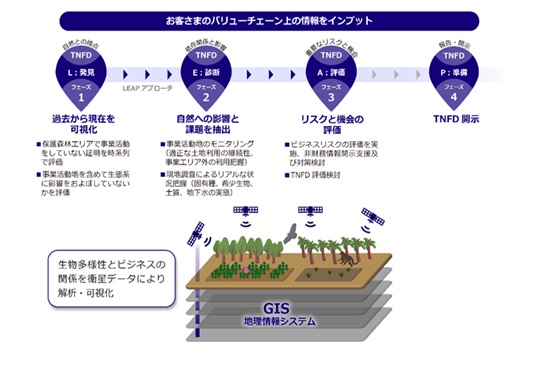
Contributions to and effects on biodiversity conservation
[Blue Bond, Blue-Sustainability Loan]
・Enhancement of national food security and sustainable food supply and revitalization of local industries of the area around the aquaculture facility.
・Prevention of marine pollution and conservation of biodiversity.
[Mizuho Nature Positive Design]
・Enable clients to achieve a higher level of commitment to nature positive by understanding the important risks and opportunities related to biodiversity and natural capital in the relevant region.
・Promote initiatives such as strengthening sustainable raw material procurement and ensuring traceability in companies engaged in business that utilizes natural capital, such as food and beverage, cosmetics, and chemical sectors.
Examples of efforts by private sector
Mizuho have identified sustainability as an integral part of our strategy and is implementing initiatives. We are contributing to creating a sustainable society, and in line with this we are expanding our direct and indirect positive impacts and reducing our negative impacts on the economy, industry, society, and the environment. In particular, we emphasize the importance of indirect impact through the provision of financing and other services and engagement with our clients, and we are continuously strengthening our efforts in both business opportunities and risk management on a group-wide basis.Specifically, on the financial side, Mizuho Securities became the first Japanese bank to serve as a structuring agent for a blue bond issue, and Mizuho Bank became the first Japanese financial institution to originate a blue-sustainability loan, creating a flow of funds for the conservation of natural capital.On the non-financial side, Mizuho Research & Technologies launched "Mizuho Nature Positive Design" service. In this service, in cooperation with Kokusai Kogyo., Ltd., uses earth observation satellite data to quickly and intuitively "identify" (L:Locate), "identify impacts and issues" (E:Evaluate), and "assess risks and opportunities" (A:Assess) areas where clients procure raw materials and where they should give priority to implementing measures to addressing the impacts of their business activities on the natural environment. This service supports clients' efforts to conserve natural capital.
THE SHIGA BANK,LTD.
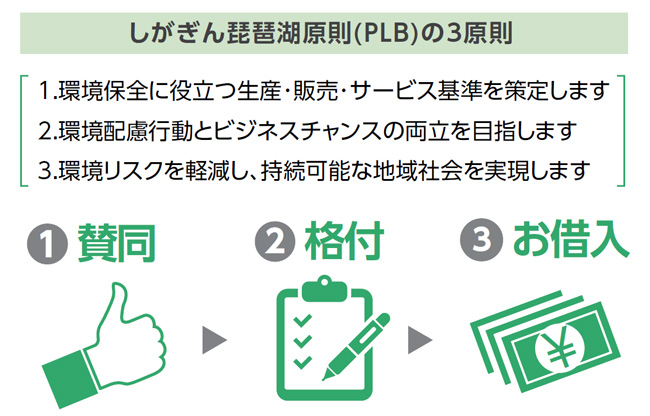
Contributions to and effects on biodiversity conservation
The Company contributes to promoting biodiversity-conscious corporate activities (e.g., mitigating the environmental footprint of supply chains) through environmental rating loans.
Examples of efforts by private sector
In 2005, the Company independently formulated the Principles for Lake Biwa for the purpose of conservation of the global environment, including Lake Biwa, and it is calling for support widely from clients. The Company implements environmental rating (PLB rating) based on original evaluation standards when requested to do so by supporting companies. At the same time, it provides loan products offering preferential interest rates based on ratings when borrowers introduce renewable energy-related equipment and energy conservation equipment. In 2009, the Company formulated the biodiversity rating system (PLB rating BD) in order to support clients' biodiversity conservation activity. Under this system, preferential interest rates, as well as PLB ratings, may be provided for activities of clients who support the goals of passing down rich biodiversity to future generations and creating a society harmonious with nature based on the measurement and evaluation of the activities using prescribed benchmarks.
Sumitomo Mitsui Trust Bank
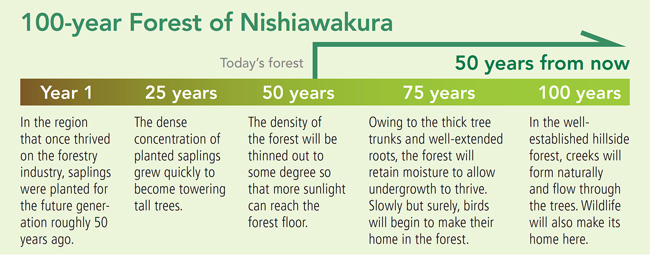
Contributions to and effects on biodiversity conservation
The Company can contribute to the exercise of forests' functions, including land preservation, water retention, and global warming control, by reviving the forestry industry through improved productivity of forest management and revitalization of the domestic lumber market.
Examples of efforts by private sector
The Company started forestry trust business activity in Nishiawakura Village, Okayama Prefecture. Forests account for 95% of the village's area size, and 84% of the forest area there is comprised of artificially planted trees. The entire village has taken on the challenge of developing a group of trees planted around 50 years ago into a majestic century-old forest. The forestry trust business provides a solution unique to a trust bank—that is, using a trust scheme to support the "100-Year Forest Plan."
Sumitomo Mitsui Trust Holdings, Inc.
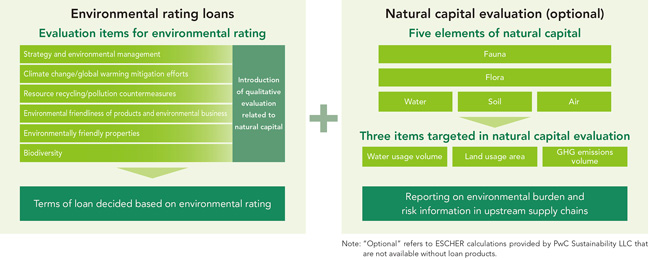
Contributions to and effects on biodiversity conservation
The Company contributes to the promotion of biodiversity-friendly corporate activities (e.g., reduction of the environmental footprints of supply chains) through the Environmental Rating Loans with the Evaluation of Natural Capital Preservation.
Examples of efforts by private sector
The Company started providing the Environmental Rating Loans with the Evaluation of Natural Capital Preservation in 2013. Among the loan screening criteria are the evaluation of corporate activities related to the environment (e.g., climate change mitigation and biodiversity conservation) and an optional evaluation of the impact on natural capital and activities related to natural capital (e.g., water usage volume, area size of land used, and GHG emission volume.
Sompo Japan Insurance Inc.
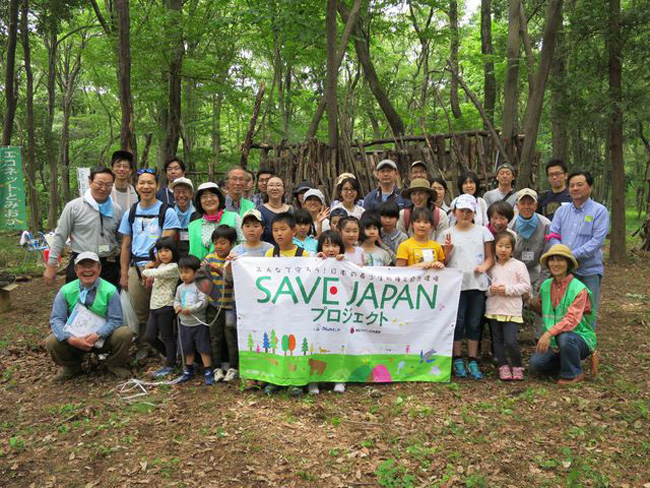
Contributions to and effects on biodiversity conservation
The Company is implementing a project to encourage diverse entities to participate in biodiversity conservation activity.
Examples of efforts by private sector
The Company cooperates with NPOs to raise interest in the natural environment and provide citizen-participating opprtunities for the education of the next generation by using funds obtained through cost reduction due to customers' selection of web-based contract terms and insurance policies and through the use of recycled products for car repairs needed due to accidents. Through cooperation between the Company's branchs across Japan and diverse local stakeholders, it is possible not only to promote understanding on biodiversity but also to encourage efforts to identify and resolve local challenges.
SWiTCH Association of Sustainability / Promotion to provide information on biodiversity through e-learning
Contributions to and effects on biodiversity conservation
Providing global perspective on environmental issues by translating the English toolkit to Japanese.
・Introduces science-based solutions to solve environmental issues.
Introducing biodiversity in an easy-to-understand manner that simplifies the messages of specialists and academia to be easier to comprehend for a wider range of citizens.
Spreading the concept of solving social and economic issues based on ecosystems change.
Promote nature positivity by introducing best practices of lifestyle and work changes that integrate decarbonization and biodiversity.
Accelerate the transition to ecosystem-based social systems and industries by spreading the the toolkit to 3.5% of Japan's population, approximately 4.4 million people.
Create communities that transcend generations and industries through seminars and workshops that lead to increased literacy and behavioral change among elementary, middle, and high school students as well as corporations.
To stimulate nature-positive initiatives in Japan by introducing global best practices to Japan.
・In the future, we will translate examples of biodiversity initiatives in Japan into English and disseminate them internationally. We will encourage participation in biodiversity activities originating in Japan to rest of the world.
Examples of efforts by private sector
In collaboration with the United Nations Environment Programme Nairobi Headquarters, and with the supervision of Japan's leading environmental academia, SWiTCH translated "GEO-6 for Youth" into Japanese. We turned the 244 page education toolkit into a free e-learning tool.
The educational material introduces the importance of a social system based on ecosystems, on which society and the economy are built, as well as the current status and challenges of the global environment and best practices from Japan and abroad on daily sustainability actions and transformational changes to work to integrate decarbonization and biodiversity.
We aim to spread the e-learning toolkit to 3.5% of Japan's population, approximately 4.4 million people. As a milestone, we aim to reach 1 million users by EXPO2025 in Osaka.
Starting with raising of youth environmental leaders selected from elementary, middle and high schools in Shibuya Ward, Hokkaido, Kyushu and Yamaguchi Prefectures. We work to improve literacy and change in behavior at corporations as well, providing opportunities for experience and exchange that transcend generations and industries.
Apart from raising climate and biodiversity literate leaders, we are empowering youth to be at the center to co-create new societal and business models in sync with our environment with universities, companies, and local governments.
ANA HOLDINGS INC.
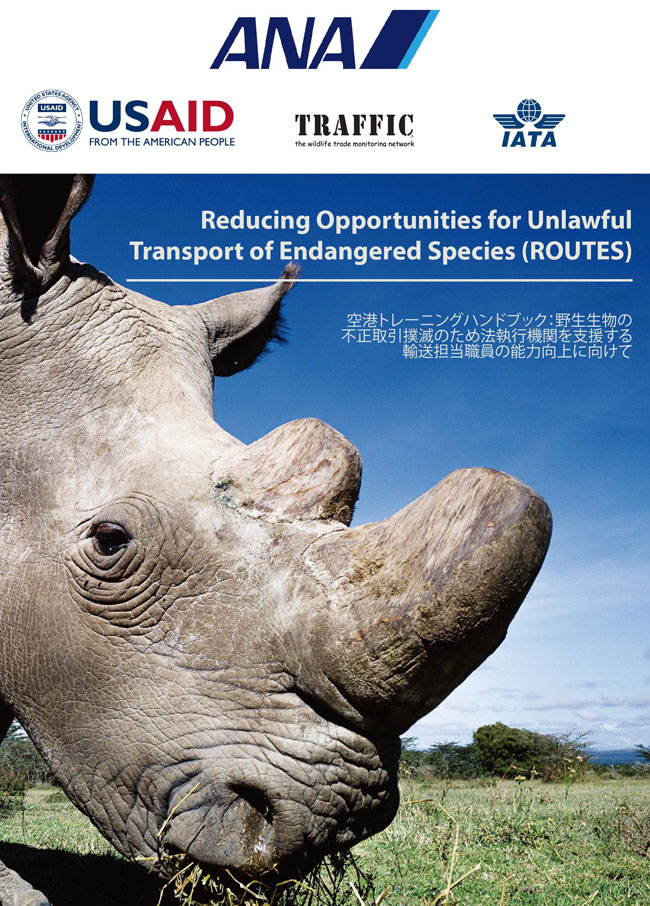
Contributions to and effects on biodiversity conservation
The Company engages in a broad range of initiatives related to biodiversity conservation as part of its social contribution activity.
Examples of efforts by private sector
○ Team Tyura Sango (from 2004): A corral conservation project in Okinawa. A team of 18 companies is conducting activities.
○ OISCA Coastal Forest Regeneration Project (from 2011 to 2020): A coastal forest regeneration project in Natori City launched in response to the damage caused by floods triggered by the Great East Japan Earthquake.
○ ANA Forest of the Heart (from 2012): Forest-growing activity by employee volunteers in Minamisanriku Town, Miyagi Prefecture. ANA has continued collaboration on the activity with Boeing Japan Office.
○ Removal of foreign species of wildlife requiring urgent action in Yambaru National Park (from 2018): We are carrying out volunteer activities to remove invasive plant species such as bitter vine that has significantly harmed the ecosystem within the park.
This is part of our efforts to support activities for its Naural World Heritage Site registration and then the park has been registrated in July 2021.
○ Buckingham Palace declaration (from 2018):We have jointly held anti-wildlife trafficking workshops with a world leading NGO "TRAFFIC", and having develped training programmes based on the ROUTES Partnership we also had a workshop for participants in and outside of the company.
SEKISUI CHEMICAL CO., LTD.
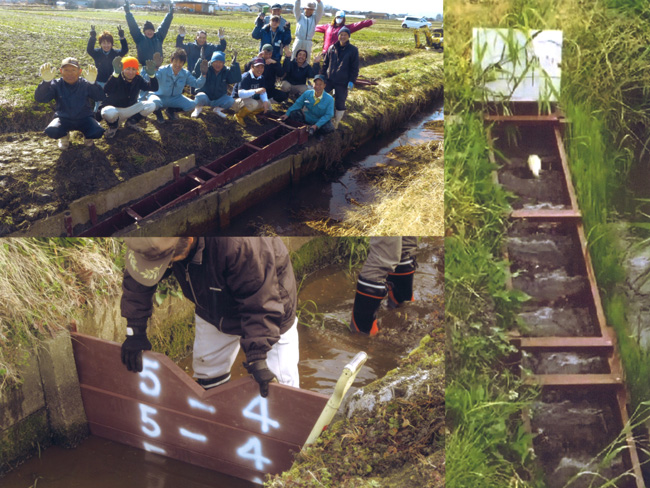
Contributions to and effects on biodiversity conservation
As part of its social contribution activity, the Company engages in a broad range of activities related to biodiversity conservation.
Examples of efforts by private sector
The Company provides scrap generated in the production of Neo Lumber FFU as materials for fishway structures that allow native fish species to migrate upstream into rice fields. The Company fabricates and installs the fishladders in cooperation with local municipalities. Efforts are made, such as adjustments to the structure (changes in the inclination angle and the distance between weir boards) and improvements to workability (reducing weight and ease of installation).
Panasonic Corporation
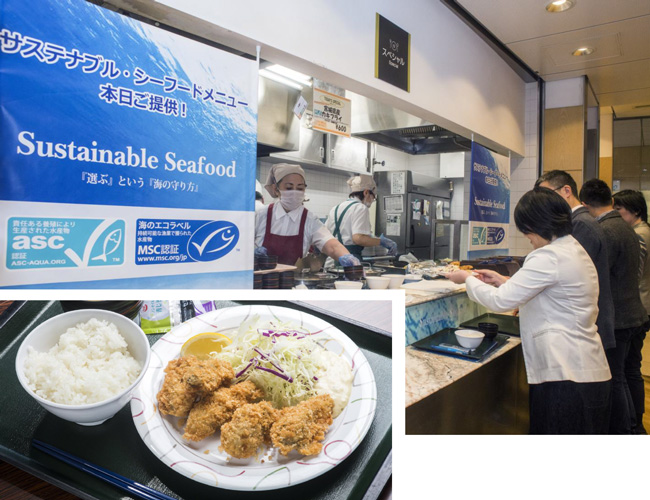
Contributions to and effects on biodiversity conservation
The company contributes to the conservation of marine ecosystems by promoting sustainable use of fish resources.
Examples of efforts by private sector
In March 2018, for the first time in Japan, the Company started to continuously use MSC- and ASC-certified sustainable fish resources at company cafeterias. By the end of March 2021, it introduced such fish resources at a total of more than 50 of its own facilities and at 38 facilities of four supporting companies. The Company aims to extend the influence of this initiative to the outside by promoting employees' understanding on sustainable seafood as the starting point for encouraging change in consumption behavior. The Company also supports the establishment of a sustainable fishing industry by promoting the acquisition of MSC/ASC certification at manufacturing bases across the world in cooperation with WWF Japan.
East Japan Railway Company(JR East)
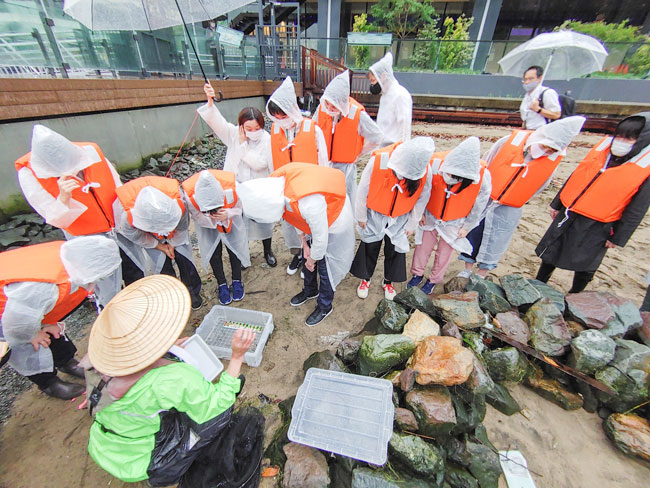
Contributions to and effects on biodiversity conservation
As part of its social contribution activity, the Company engages in a broad range of initiatives related to biodiversity conservation.
Examples of efforts by private sector
○ Local forest development in (from 2004): Activity to regenerate forests by planting native species of trees.
○ Reduction of plastics (from 2019): A plastics reduction campaign that promotes the replacement of plastic shopping bags and straws used at JR East Group's directly operated shopping and other facilities, including railway station shops and hotels, with bags and straws using biomass-based and bio-degradable materials.
○ The Company has developed tidal flats at the WATERS takeshiba multicomplex facility and conducted observation and survey activities regarding aquatic creatures in cooperation with local schools.
○ Visiting lessons for environmental education (from 2009): An education program whereby employees working as station staff and train conductors and operators visit elementary schools in person and help students understand environmental issues.
Mitsubishi Electric Corporation
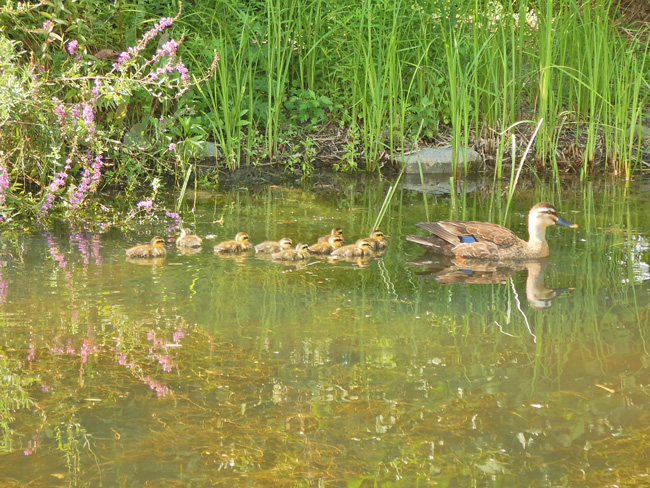
Contributions to and effects on biodiversity conservation
As part of its social contribution activity, the Company engages in a broad range of initiatives related to biodiversity conservation.
Examples of efforts by private sector
○ Biodiversity preservation at business sites: The Mitsubishi Electric Group’s business sites are devoting efforts to creating an environment favorable for symbiosis with living creatures. One of them whose environmental initiative, such as building biotope, installation of green louvers, and Satoyama Woodland Preservation activities, has been approved, has acquired certification from external organization. Using this biotope, the business site held creatures observation for local nursery children, creating opportunities for them to commune with nature. Another business site contributes to developing local ecosystem networks by turning green areas on its premises into "resting green zone" for birds and insects. The Company is also striving to raise interest in biodiversity by actively disseminating information to employees.
○ Satoyama Woodland Preservation Project: Since October 2007, the Company has engaged in activities to restore local nature across Japan, including parks, forests and rivers around its business sites (39 activities held in FY2020). For example, the Company has signed an agreement on corporate forest development named “Kigyou No Mori Zukuri”, under which its factories and branch offices engage in the development of prefecture-owned forests and beautification activity in cooperation with local residents and relevant organizations.
○ Mitsubishi Electric Outdoor Classroom : Employees act as leaders and engage in activity for hands-on nature experience together with local children (26 lessons provided in FY2020). Employees and children at nurseries in the neighborhood engage in nature observation in forests. Children can become familiar with animals and plants to which they are not accustomed and learn the importance of nature.
Mitsubishi UFJ Financial Group, Inc.
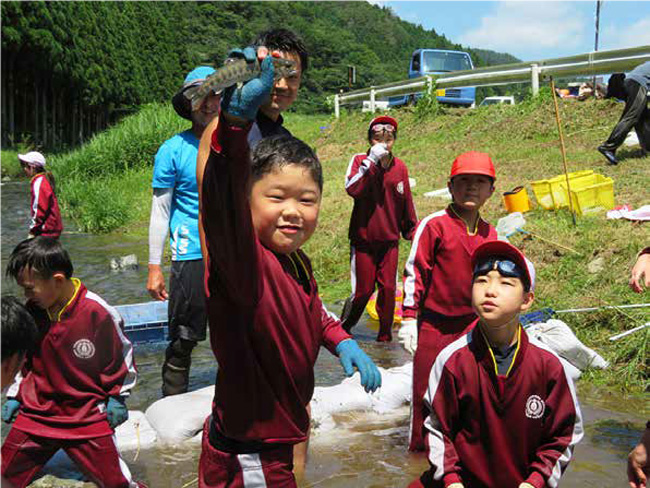
Contributions to and effects on biodiversity conservation
As part of its social contribution activity, the company engages in a wide range of initiatives related to biodiversity conservation.
Examples of efforts by private sector
○ Environment Education Project Midori-no-e Contest
The Company holds Environment Education Project Midori-no-e Contest in order to encourage children to become familiar with nature and learn about its beauty and importance.
○ Supporting the Activities of UNESCO Associated Schools
Based on the idea that, in order to protect the richness of the natural environment and pass it down to children on whose shoulders the future rests, it is important to create a sustainable society with a small environmental footprint, the company is actively supporting SDGs education at schools in cooperation with the National Federation of UNESCO Associations in Japan in order to foster future generations of people who play an essential role in realizing and maintaining a sustainable society.
KDDI CORPORATION / Biodiversity Conservation and Education Initiatives with Ashiu Forest Research Station.

Contributions to and effects on biodiversity conservation
As part of its social contribution activities, the company engages in a wide range of activities related to biodiversity conservation.
Examples of efforts by private sector
・KDDI and Kyoto University's Ashiu Forest Research Station signed a comprehensive collaboration agreement with the aim of contributing to the conservation of biodiversity and ecosystems in the Station as well as to the promotion of education and research.
・During the difficult period for education due to the COVID-19 pandemic, KDDI and Kyoto University jointly produced a VR movie that allows students to virtually experience the pristine forest and use it for university education. The video was also made available to the public at events and on the website, and was used to publicize the Ashiu Forest Research Station.
・Employee volunteers installed and replaced fences to protect the understory vegetation from overgrazing by the increasing population of Japanese sika deer.
・As a demonstration experiment, box traps using LPWA (Low Power Wide Area; a wireless communication technology that enables long-distance data communication with low power consumption) and an IoT anti-bird and beast notification system were installed in a mountain forest area that is out of cell phone range to conduct pest control (licensed capture) of deer.
- Target1
- Target2
- Target3
- Target4
- Target5
- Target6
- Target7
- Target8
- Target9
- Target10
- Target11
- Target12
- Target13
- Target14
- Target15
- Target16
- Target17
- Target18
- Target19
- Target20
- Target21
- Target22
- Target23
- Others
